Paul Bishop's Blog, page 22
September 18, 2017
OUT OF THE SHADOWS—JAMES MCKIMMEY
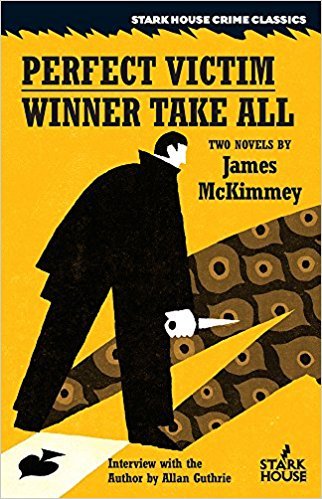 OUT OF THE SHADOWSJAMES MCKIMMEY
OUT OF THE SHADOWSJAMES MCKIMMEYI’ve immersed myself in the noir/crime/mystery genre for many years as a reader, writer, collector, and enthusiast. I consider myself relatively well versed in not only the mainstay writers and novels in the field, but also many of those hidden in the more obscure corners. However, the genre is mind-bogglingly wide making it near impossible to have read or be familiar with all of the once highly prominent writers who have now slipped into obscurity. Many of these writers have been overshadowed, at times unfairly, by those greats recognized not only within the genre, but within the general reading public at large.
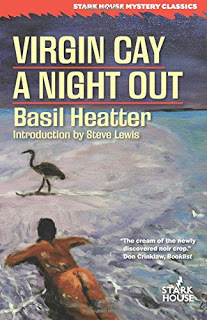
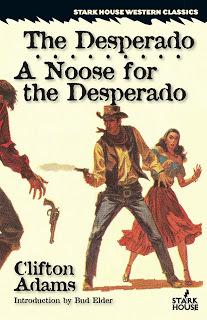 So it is, I revel in the chinks Stark House Press reveals in my reading armor by regularly publishing new collections of these forgotten gems under their Crime Classics banner. Not only are these collections packaged and priced attractively, the introductions by prominent names in the genre are often as valuable as the original prose that follows. This year alone, Stark House has brought me up to speed on
Basil Heatter
,
Peter Rabe
,
Clifton Adams
, and
Carter Brown
—three authors with whom I was familiar, but had never read, and another I was only aware of as a writer of Westerns. They also published the outstanding collection of introductions and essays by Rick Ollerman (
Hardboiled, Noir and Gold Medals
), which I wrote about in an earlier column.
So it is, I revel in the chinks Stark House Press reveals in my reading armor by regularly publishing new collections of these forgotten gems under their Crime Classics banner. Not only are these collections packaged and priced attractively, the introductions by prominent names in the genre are often as valuable as the original prose that follows. This year alone, Stark House has brought me up to speed on
Basil Heatter
,
Peter Rabe
,
Clifton Adams
, and
Carter Brown
—three authors with whom I was familiar, but had never read, and another I was only aware of as a writer of Westerns. They also published the outstanding collection of introductions and essays by Rick Ollerman (
Hardboiled, Noir and Gold Medals
), which I wrote about in an earlier column. In December, Stark House will release a collection of two novels, Perfect Victim/Winner Take All , by James McKimmey, introduced with an interview with McKimmey conducted by Allen Guthrie. This will be the second collection of McKimmey novels from Stark House, the first being Cornered!/The Long Ride , with an introduction by Bill Crider.
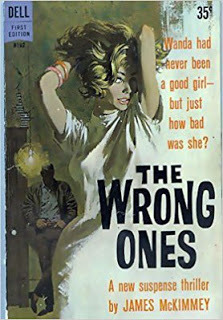
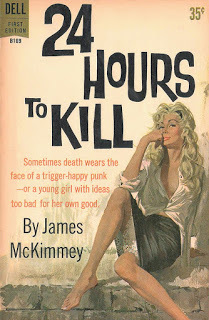
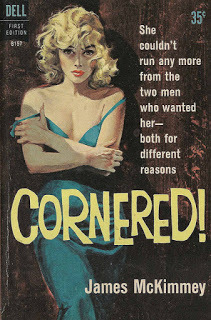
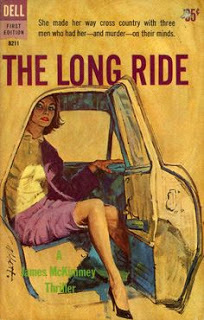
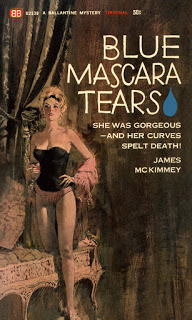 McKimmey was an author who had never registered on my radar, but after reading Perfect Victim/Winner Take All, I immediately purchased Stark House’s first collection of McKimmey stories. I wanted more McKimmey, and I wanted it right away. The second I check out the Internet and recognized the amazing Robert McGinnis covers on the Dell paperbacks of McKimmey’s novels, I knew I’d seen McKimmey’s books before. I even had a couple on my shelf collected for the McGinnis covers, but never cracked open and read—a situation quickly rectified.
McKimmey was an author who had never registered on my radar, but after reading Perfect Victim/Winner Take All, I immediately purchased Stark House’s first collection of McKimmey stories. I wanted more McKimmey, and I wanted it right away. The second I check out the Internet and recognized the amazing Robert McGinnis covers on the Dell paperbacks of McKimmey’s novels, I knew I’d seen McKimmey’s books before. I even had a couple on my shelf collected for the McGinnis covers, but never cracked open and read—a situation quickly rectified.Best known for his crime fiction, McKimmey began his writing career churning out science fiction, juvenile, Western, and adventure stories for the pulps. Looking to move up the pay scale, McKimmey began writing for the slicks (Saturday Evening Post, Colliers, etc.) in the mid-50s. His first novel, Perfect Victim, sold to Dell in 1957.
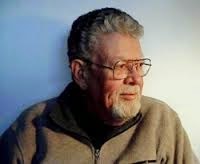 McKimmey’s story structure is to present seemingly unrelated characters and eventually connecting them as needed to bring the plot to a boil. He establishes his main characters (and even his secondary characters to some extent) and our belief in them through the technique of dynamic dialogue, with his style relying minimally on descriptive passages. This keeps the story moving fast enough to keep the reader from thinking too hard about the coincidences and, at times, artificial set-ups, which often drive these types of stories.
McKimmey’s story structure is to present seemingly unrelated characters and eventually connecting them as needed to bring the plot to a boil. He establishes his main characters (and even his secondary characters to some extent) and our belief in them through the technique of dynamic dialogue, with his style relying minimally on descriptive passages. This keeps the story moving fast enough to keep the reader from thinking too hard about the coincidences and, at times, artificial set-ups, which often drive these types of stories.Reading like Jim Thompson filtered through the lens of James M. Cain, David Goodis, and John D. MacDonald, McKimmey deserves to be rediscovered and have a much higher profile with fans of compulsively readable tight, nasty, and twisted noirs. Kudos again to Stark House Press for keeping the flame burning.
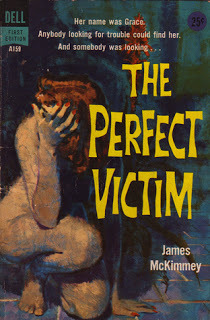 THE PERFECT VICTIM
THE PERFECT VICTIM Al Jackson, traveling salesman, knows that he isn’t likely to get any equipment sales in Willow Creek, but he’s nursing a hangover and stops here anyway. He’s a friendly guy, on the road too long, and can’t help flirting with the waitress, Grace. But Willow Creek folks don t take well to outsiders making time with their Grace. So when she is found murdered the next morning, everyone naturally assumes that the foreigner must have had something to do with it. And now Jackson is in jail while the town howls for blood. Only the real murderer knows what happened and he has no intention of letting the salesman live to see a courtroom.
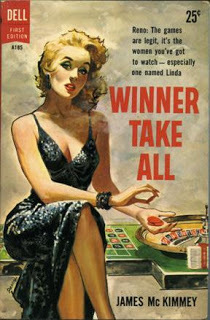 WINNER TAKE ALL
WINNER TAKE ALL You've kicked around the world, a soldier of fortune. But nothing prepares you for a man who shows up in your San Francisco hotel claiming to be your twin, with an offer to switch places for ten thousand dollars. Yeah, there's going to be some rough stuff you've got to settle your twin's gambling debt with some very dubious characters in Reno but the money looks good, and you're up for it. You get to live the high life for a while, which is something you could definitely get used to. But you don't figure on lovely Linda. And you sure don't figure on the neat double-cross that saps you right between the ears. Because, my friend, you've been swapped for murder!
Published on September 18, 2017 12:49
September 11, 2017
THE WOMEN OF MEN’S ADVENTURE
 THE WOMEN OF MEN’S ADVENTURE The paperback original men’s adventure and western series of the seventies and eighties provided a fertile proving ground for dozens of authors—some of whom wrote hundreds of books in the near uncountable number of series which proliferated during the time period. The huge majority of the writers of these action oriented, violence dripping, sex soaked series filled with lone wolf vigilantes, elite military teams, shoot first cops, lusty international spies, billionaire adventurers, and the many other variations had one thing in common—they were males. While they weren’t necessarily as hairy-chested, muscular, or quick-triggered as their fictional creations, they were certainly toiling in the traditionally male written, testosterone filled, genre.
THE WOMEN OF MEN’S ADVENTURE The paperback original men’s adventure and western series of the seventies and eighties provided a fertile proving ground for dozens of authors—some of whom wrote hundreds of books in the near uncountable number of series which proliferated during the time period. The huge majority of the writers of these action oriented, violence dripping, sex soaked series filled with lone wolf vigilantes, elite military teams, shoot first cops, lusty international spies, billionaire adventurers, and the many other variations had one thing in common—they were males. While they weren’t necessarily as hairy-chested, muscular, or quick-triggered as their fictional creations, they were certainly toiling in the traditionally male written, testosterone filled, genre.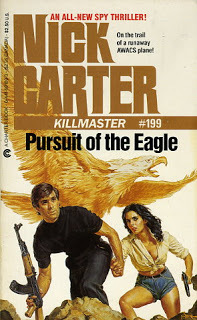 While the low rent end of Hemmingway Street was customarily male, there were a surprising number of women writers who embraced the macho guidelines of the genre—matching their male counterparts bullet for bullet, violence for violence, and sexual kink for sexual fetish. They infiltrated the genre seamlessly, proven by the fact no men’s adventure series reader ever stopped reading the latest installment, outraged because, “Hey! This was written by a broad!”
While the low rent end of Hemmingway Street was customarily male, there were a surprising number of women writers who embraced the macho guidelines of the genre—matching their male counterparts bullet for bullet, violence for violence, and sexual kink for sexual fetish. They infiltrated the genre seamlessly, proven by the fact no men’s adventure series reader ever stopped reading the latest installment, outraged because, “Hey! This was written by a broad!”Fortunately, a number of women writers who braved the world of men’s action adventure paperback series were willing to share their experiences…
GAYLE LYNDSGayle Lynds, now the acknowledged Queen Of Modern Espionage Fiction, began her literary spy career writing adventures for the Nick Carter: Killmaster series. The author of 10 bestselling international spy novels—including The Assassins, The Book of Spies, and The Last Spymaster—speaks freely about her early experiences in the men’s adventure genre...
 In the early 1980s, I was divorced and struggling to find a way to support my two children. I was writing literary short stories, which I loved, but I was paid in copies of the journals in which they were published. Since paper was not a food group, and my children had grown accustomed to eating, and since the magazine I was editing wasn’t paying enough to support us, I turned to writing male pulp novels.
In the early 1980s, I was divorced and struggling to find a way to support my two children. I was writing literary short stories, which I loved, but I was paid in copies of the journals in which they were published. Since paper was not a food group, and my children had grown accustomed to eating, and since the magazine I was editing wasn’t paying enough to support us, I turned to writing male pulp novels. 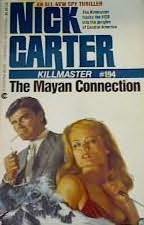 This serendipity was due to my husband-to-be, Dennis Lynds, aka Michael Collins, who signed the contracts and created the outlines for two Nick Carter novels, which I then wrote. The Nick Carter series has been around for decades, written by many male authors, and is sometimes described as an American version of James Bond. After I’d finished the first two, I insisted I take over creating the outlines for the next books in the contract. This was because I wanted to learn how to think the bones of a book.
This serendipity was due to my husband-to-be, Dennis Lynds, aka Michael Collins, who signed the contracts and created the outlines for two Nick Carter novels, which I then wrote. The Nick Carter series has been around for decades, written by many male authors, and is sometimes described as an American version of James Bond. After I’d finished the first two, I insisted I take over creating the outlines for the next books in the contract. This was because I wanted to learn how to think the bones of a book.In the end, I wrote five Nick Carters, all of which had international settings and were based on international political intrigue. I know that sometimes people are shocked I would “lower” myself to write pulp fiction, but I looked upon it as an exciting opportunity to grow and experiment as a writer. And, too, Dean Koontz and Martin Cruz Smith and Ross Macdonald and my husband and other fine authors had plowed those literary fields early in their careers. Why shouldn’t I?
Did the publisher ever know I was doing it? I doubt it. The contracts were in Den’s name because he was a known quantity, which meant we got the highest pay grade — a shockingly low $3,000 per book. Wahoo! But money was money, and I gloried in being allowed to experiment with character, scenes, and voice. I was even able to do multiple viewpoints. I looked upon it as a graduate course in popular writing...
TO VISIT GAYLE LYNDS’ WEBSITE CLICK HERE
MOLLY COCHRANMolly Cochran is the author of 27 published novels and four nonfiction books under her own name and various pseudonyms—including the teen paranormal romances Legacy, Poison, and Seduction. With co-author Warren Murphy, she also wrote the New York Times bestselling novels Grandmaster and The Forever King. She has lectured extensively and has taught writing at the college level as well as at a women's prison—insisting she was not an inmate at the time. In her dark and mysterious past, she also contributed a clutch of novels to one of the most iconic men’s adventure paperback series, The Destroyer. Molly remembers her time ghosting The Destroyerfondly...
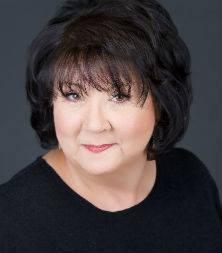 I think most Destroyer fans know I was one of several ghost writers who worked on the series. The fact I’m a woman hasn’t seemed to make much difference in the public’s response to my work, which has been pretty positive. Where it did make a difference was in my own grasp of the craft.
I think most Destroyer fans know I was one of several ghost writers who worked on the series. The fact I’m a woman hasn’t seemed to make much difference in the public’s response to my work, which has been pretty positive. Where it did make a difference was in my own grasp of the craft. Writing men’s action/adventure stretched me far beyond anything I might have reached for on my own. The Destroyer is not a vehicle for dreamy setups or vague descriptions, faults shared by many (bad) women’s novels. It is fast, action-packed, and plot driven. Ghosting this iconic series gave me discipline, confidence, and the ability to work under pressure.
As a writer, I have nothing but the deepest gratitude to Warren Murphy and Dick Sapir (who was still alive when I began ghosting for them). The twelve Destroyers I wrote provided the best postgraduate course in fiction writing I can imagine. Here are some of the things I learned directly from Warren, who was my main mentor:
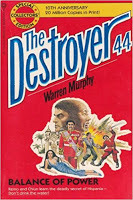
—People aren’t going to pay as much attention to every word as you do. When writing action, tell them you’re going to do it, do it, then tell them you did it.
—Nothing in a novel is inconsequential.
—Reaction propels the story forward as much as action.
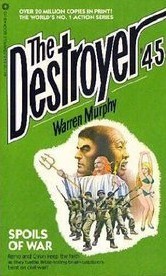 —Make sure every character’s motives are (or become) clear. People can be ambiguous, but fictional characters cannot.
—Make sure every character’s motives are (or become) clear. People can be ambiguous, but fictional characters cannot.—Writers don’t lose their talent. What they lose is their nerve. Don’t lose it. Always be willing to fall on your face.
After I completed my dozen Destroyers, Warren and I co-wrote Grandmaster, which won an Edgar Award, rose to #3 on the New York Times Bestseller List, and became an international bestseller. All in all, we wrote seven successful books together. Oh, and incidentally, we got married...Good times...
TO VISIT MOLLY COCHRAN’S WEBSITE CLICK HERE
ALICE DUNCANAuthor of romance westerns and the popular Daisy Gumm Majesty series set in the Roaring Twenties, Alice Duncan also made her bones in the world of men’s adventure fiction. Having written two books in the Trailsman adult western series (under the house name Jon Sharpe), Alice has her own slant on the quirks and challenges of the genre...
It was early in what I laughingly call my writing career, and I was incredibly single-minded and ambitious (a tendency I’ve since gotten over). I wanted to write everything. I’d written western romances and thought maybe I could write straight westerns without the romantic element.
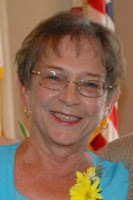 My agent approached an editor at Signet (can’t remember his name, but I do remember he was Canadian and his family had Beaucerons—a breed of guard and herding dog—working on their ranch). My agent had sent the editor a proposal for a western I was working on.
My agent approached an editor at Signet (can’t remember his name, but I do remember he was Canadian and his family had Beaucerons—a breed of guard and herding dog—working on their ranch). My agent had sent the editor a proposal for a western I was working on.The editor said he admired my writing, and would I like to write for the Trailsman series? I said sure, and went out and bought two of the novels. I knew the books contained a lot of sex, because my agent had warned me. I’d had an idea of having three pseudo-nuns running into Trailsman hero, Skye Fargo (and people say romance heroes have weird names). However, the first Trailsman book I read had three nuns in it. So, I scrapped that idea and decided to write a book set in the Pecos Valley in New Mexico Territory.
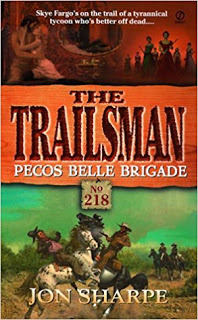 My new plot involved an evil rancher who has taken over a town. Skye Fargo intervenes and organizes a bunch of hookers to free the town from the rancher’s grip. As soon as the editor read the book (fortunately, those things were short), he said I had to rewrite it, as I’d clearly totally missed the concept of Skye Fargo being at every woman’s mercy. Even 18-year-old virgins seduced him (didn’t take much effort on their part). So, I made the required changes.
My new plot involved an evil rancher who has taken over a town. Skye Fargo intervenes and organizes a bunch of hookers to free the town from the rancher’s grip. As soon as the editor read the book (fortunately, those things were short), he said I had to rewrite it, as I’d clearly totally missed the concept of Skye Fargo being at every woman’s mercy. Even 18-year-old virgins seduced him (didn’t take much effort on their part). So, I made the required changes.The second book was set in Gold-Rush California and involved a fake woman preacher who was really an evil gambler. Skye Fargo manages to fool her, ruin her career as a fake evangelist, and save the town from further depravity—at least from her. They still had plenty of depravity going on from other sources. The editor said he still liked my writing, but he needed folks to write Trailsman books whose work didn’t need so much correction from him. I understood completely.
The main problem I had with the Trailsman-like westerns was writing too much introspection and too little action. I also absolutely and totally did NOT comprehend the male-fantasy aspect of the books, which had every woman alive wanting to jump Skye Fargo’s bones. Never mind he had a huge beard and wore buckskins that probably never got laundered (how do you launder buckskins anyway?), and he never had to make a move on a woman. All I could think of when I was writing those two books was how stinky Skye Fargo must be, you know? Not to mention how many people Skye had to kill in order to fulfill his purpose on earth.
Anyway, that ended my Trailsman career. A shame, too, because those books made me more money than any other books I’ve ever written. Sigh...
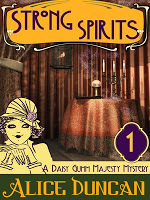 Along with writing her own Jazz Age cozies, Alice also edits the westerns for Five Star written by Peter Mean Pete Brandvold—who also cut his teeth writing Trailsmannovels. About Peter, Alice says, He’s a great writer, and he’s got the western thing down pat. In fact, I always lose track of the body count when I edit his books. Mean Pete KNOWS what a western is supposed to be. Wish I did. Oh, well...
Along with writing her own Jazz Age cozies, Alice also edits the westerns for Five Star written by Peter Mean Pete Brandvold—who also cut his teeth writing Trailsmannovels. About Peter, Alice says, He’s a great writer, and he’s got the western thing down pat. In fact, I always lose track of the body count when I edit his books. Mean Pete KNOWS what a western is supposed to be. Wish I did. Oh, well...TO VISIT ALICE DUNCAN’S WEBSITE CLICK HERE
MARILYN GRANBECKWriting as Marilyn Granbeck, Marilyn Ruth Henderson created and wrote all novels in two men’s adventure series—The Peacemaker and Blood. She also wrote one entry in the Nick Carter Killmaster series. Now a respected mystery writer, Granbeck believes her time writing men’s adventure novels set her up for success...
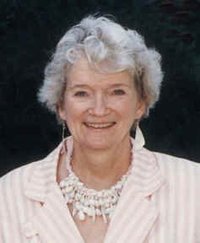 I began with short stories under the mistaken impression that short meant easier. I sold my first one eleven months after I had set my goal. During this time though, a remarkable thing had happened. One of the selling members of the writers' group offered to help me. He wrote and sold action/adventure and mystery/suspense paperback originals to a small Midwestern publisher I never knew existed. He gave me some of his books to read to see if I thought I could write the kind the publisher wanted.
I began with short stories under the mistaken impression that short meant easier. I sold my first one eleven months after I had set my goal. During this time though, a remarkable thing had happened. One of the selling members of the writers' group offered to help me. He wrote and sold action/adventure and mystery/suspense paperback originals to a small Midwestern publisher I never knew existed. He gave me some of his books to read to see if I thought I could write the kind the publisher wanted.That was my first real recognition that writing a book that sells meant writing for the intended market, not for myself. I had to come up with an idea and write a book the editor knew his readers would buy. Learning that important basic of marketing put me on the road to success. When I asked my mentor how I could ever repay him, he said—Pass it on some day…
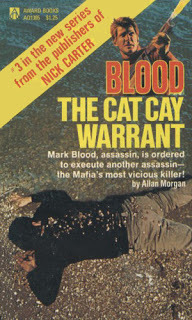 On his Glorious Trashblog, Joe Kenney gave an interesting perspective on Granbeck’s men’s adventure work in her Blood series...Granbeck usually fades to black in the sex scenes, though sometimes she gives a bit of the juicy details. It’s not full-on explicit but it’s more than nothing, and she has no qualms with describing the female anatomy. She even goes the extra mile by occasionally referring to breasts as tits. So clearly, she was making the attempt to cater to the demands of the genre. And yet for all of that, you can still detect something afoot, as Blood appears to develop feelings for most every girl, and indeed tells us he can’t have sex if there are no feelings involved – what more proof do you need that the writer was a woman?
On his Glorious Trashblog, Joe Kenney gave an interesting perspective on Granbeck’s men’s adventure work in her Blood series...Granbeck usually fades to black in the sex scenes, though sometimes she gives a bit of the juicy details. It’s not full-on explicit but it’s more than nothing, and she has no qualms with describing the female anatomy. She even goes the extra mile by occasionally referring to breasts as tits. So clearly, she was making the attempt to cater to the demands of the genre. And yet for all of that, you can still detect something afoot, as Blood appears to develop feelings for most every girl, and indeed tells us he can’t have sex if there are no feelings involved – what more proof do you need that the writer was a woman?JOANNE WALPOLEJoanne (Jo) Walpole is an establish writer of Black Horse Westerns under the pseudonym Terry James (a name apparently stolen from her husband). A Piccadilly Cowboy for a new generation, Jo’s new violent Western series Maggie O’Bannen is about to make a cannonball splash into the waters of men’s adventure series under the pseudonym Joe Slade. On her blog, Jo talks about her new series...
 Not long ago, I approached Piccadilly Publishing with an idea for a series. I wanted the freedom to 'go large', as I put it, and break away from the mainstream type westerns I had previously written. They were happy to let me run with it and off I went.
Not long ago, I approached Piccadilly Publishing with an idea for a series. I wanted the freedom to 'go large', as I put it, and break away from the mainstream type westerns I had previously written. They were happy to let me run with it and off I went.Recently, I submitted the first book in the Maggie O’Bannen series—Days Of Evil. It only took me 2 months to write from start to finish, which was a record for me and proves how much I enjoyed doing it. I'd go so far as to say it's my favourite book out of the seven I have had published since 2005. Piccadilly seem to agree.
I decided to use a different pseudonym for this one as it's more violent than anything I've written before and I wanted to draw a line of distinction between Terry James [the pseudonym she uses for her more traditional Black Horse Westerns) and this new version of me.
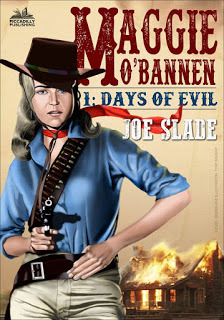 I'm very lucky to have had Tony Masero design the cover. I admit I was a little nervous as the women I'd seen on some of the Piccadilly covers tended towards overtly sexy and Maggie isn't that. I provided an overview of how I saw her and I think Tony Masero has done a really good job with her. I very much like the simplicity of the cover art overall.
I'm very lucky to have had Tony Masero design the cover. I admit I was a little nervous as the women I'd seen on some of the Piccadilly covers tended towards overtly sexy and Maggie isn't that. I provided an overview of how I saw her and I think Tony Masero has done a really good job with her. I very much like the simplicity of the cover art overall.The second book in the series is already under way with the working title, Wanted: Dead. I'm still very excited about Maggie and her band of misfits and am very much hoping readers will take to them as much as I have...
Maggie O’Bannen #1: Days Of Evil will be available November 6, 2017.
TO VISIT JO WALPOLE’S WEBSITE CLICK HERE
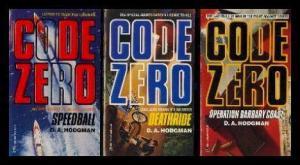 DOROTHY AYOOB In the mid-'90's there were two men’s adventure series, Stakeout Squad and Code Zero, written by D. A. Hodgman. Both series were highly regarded series due to their high degree of verisimilitude regarding police procedure and the technical detail relating to firearms and ammunition.
DOROTHY AYOOB In the mid-'90's there were two men’s adventure series, Stakeout Squad and Code Zero, written by D. A. Hodgman. Both series were highly regarded series due to their high degree of verisimilitude regarding police procedure and the technical detail relating to firearms and ammunition.
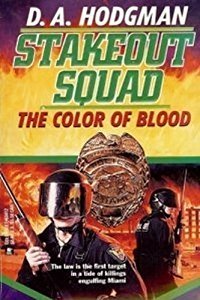 Reader Phil Wong felt the books read like a fictionalized version of the Ayoob Files, a regular column in the American Handgunnermagazine. In Wong’s opinion there was a strong chance D. A. Hodgman was a nom de plume for Massad Ayoob. Wong finally met Massad Ayoob in person. Hoping to get his copies of Stakeout Squad and Code Zero autographed, he asked Ayoob if he was indeed the man behind the D. A. Hodgman pseudonym. It turned out, however, D. A. stood for Dorothy Ayoob neé Hodgman, who had been Massad's wife. Massad served as the primary technical advisor on the books, but the actual writing was all done by Dorothy.
Reader Phil Wong felt the books read like a fictionalized version of the Ayoob Files, a regular column in the American Handgunnermagazine. In Wong’s opinion there was a strong chance D. A. Hodgman was a nom de plume for Massad Ayoob. Wong finally met Massad Ayoob in person. Hoping to get his copies of Stakeout Squad and Code Zero autographed, he asked Ayoob if he was indeed the man behind the D. A. Hodgman pseudonym. It turned out, however, D. A. stood for Dorothy Ayoob neé Hodgman, who had been Massad's wife. Massad served as the primary technical advisor on the books, but the actual writing was all done by Dorothy.
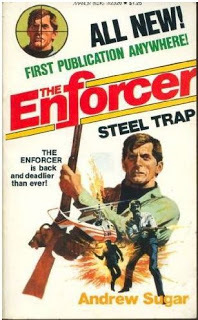 ANDREW / ANDREA SUGAR Then there is the odd case of Andrew Sugar who wrote action and violence filled men’s adventure series such as the body-hopping-clone series The Enforcer, and the butt-kicking Israeli Commandos. Sugar famously sued Warner Bros. over their authorized novelization of The Enforcer—based on Clint Eastwood’s Dirty Harry film—claiming it had substantially injured him financially and caused damage to his property rights.
ANDREW / ANDREA SUGAR Then there is the odd case of Andrew Sugar who wrote action and violence filled men’s adventure series such as the body-hopping-clone series The Enforcer, and the butt-kicking Israeli Commandos. Sugar famously sued Warner Bros. over their authorized novelization of The Enforcer—based on Clint Eastwood’s Dirty Harry film—claiming it had substantially injured him financially and caused damage to his property rights.
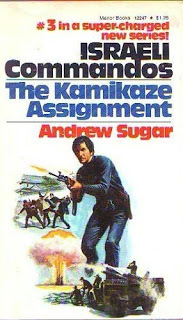 At the time of the court filing, however, Andrew Sugar had undergone a sex change operation and was now Andrea Sugar. An expert witness in the case stated Sugar wasn’t a bad looking woman, allowing for a missing lower front tooth. Sugar was highly regarded as a men’s adventure novelist, which adds a certain irony to his journey as a woman starting out in a man’s body.
At the time of the court filing, however, Andrew Sugar had undergone a sex change operation and was now Andrea Sugar. An expert witness in the case stated Sugar wasn’t a bad looking woman, allowing for a missing lower front tooth. Sugar was highly regarded as a men’s adventure novelist, which adds a certain irony to his journey as a woman starting out in a man’s body. ****** There are also numerous other examples of women writers exercising their literary muscles by contributing to men’s adventure paperback series.
J.B. KELLER
Keller wrote many entries in the Trailsman series. Her significant other was Trailsman series creator Jon Messmann—whose name is very well known in men’s adventure series circles as the creator of Jefferson Boone: The Handyman, The Revenger, and many more action series. However, when it comes to the Trailsman series, it’s unclear which of the two wrote which books—various books credited to Keller were written by Messmann and vice-versa.
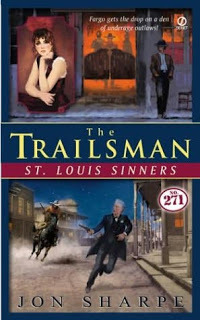 ELLEN RECKNOREllen Recknor wrote at least four entries in the Trailsman series as Jon Sharpe. She also wrote four Slocum books under the Jake Logan house name—three of which were Giant Editions. Unfortunately, there is no central listing to identifying the individual authors behind the Jake Logan pseudonym or which books they wrote. Unlike the listings for the Trailsman series on the U.S. Copyright site (where authors can be identified by painstakingly checking each entry), the great majority of the Slocumbooks do not have similar specific author information.Recknor had a lifelong interest in the Old West, which she found useful when she began her writing career. In 1998 she won a Spur Award from the Western Writers of America for Best Paperback Original, for Leaving Missouri. In 2000, she won the Best Novel of the West Spur Award for Prophet Annie. She passed away in 2014.
ELLEN RECKNOREllen Recknor wrote at least four entries in the Trailsman series as Jon Sharpe. She also wrote four Slocum books under the Jake Logan house name—three of which were Giant Editions. Unfortunately, there is no central listing to identifying the individual authors behind the Jake Logan pseudonym or which books they wrote. Unlike the listings for the Trailsman series on the U.S. Copyright site (where authors can be identified by painstakingly checking each entry), the great majority of the Slocumbooks do not have similar specific author information.Recknor had a lifelong interest in the Old West, which she found useful when she began her writing career. In 1998 she won a Spur Award from the Western Writers of America for Best Paperback Original, for Leaving Missouri. In 2000, she won the Best Novel of the West Spur Award for Prophet Annie. She passed away in 2014.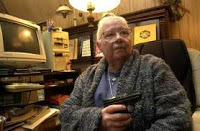 ARDATH MAYHARAs John Killdeer, Mayhar wrote the first six books in the Mountain Majesty series, in which frontiersman Cleve Bennett and his Cheyenne warrior wife fight for their high mountain freedom.Mayhar was nominated for the Mark Twain Award as well as numerous other nominations for awards in almost every fiction genre. She won many awards for her poetry. In 2008, she was honored by Science Fiction and Fantasy Writers of America as an Author Emeritus. Mayhar wrote over 60 books ranging from science fiction to horror to young adult to historical to westerns. Mayhar passed away in 2012.
ARDATH MAYHARAs John Killdeer, Mayhar wrote the first six books in the Mountain Majesty series, in which frontiersman Cleve Bennett and his Cheyenne warrior wife fight for their high mountain freedom.Mayhar was nominated for the Mark Twain Award as well as numerous other nominations for awards in almost every fiction genre. She won many awards for her poetry. In 2008, she was honored by Science Fiction and Fantasy Writers of America as an Author Emeritus. Mayhar wrote over 60 books ranging from science fiction to horror to young adult to historical to westerns. Mayhar passed away in 2012.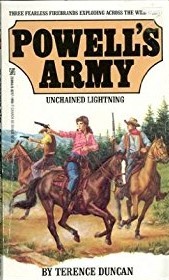 BARBARA PUECHNERAs Terence Duncan, Barbara Puechner wrote the first three books in the eight book Powell’s Armyseries. The title character of the series is Lt. Col. Amos Powell, who leads an army of fearless firebrands consisting of former soldier/Ranger Landrum Davis, the Dartmouth educated Gerald Glidinghawk, and Celia Burnett—who was adept at both shooting and riding.
BARBARA PUECHNERAs Terence Duncan, Barbara Puechner wrote the first three books in the eight book Powell’s Armyseries. The title character of the series is Lt. Col. Amos Powell, who leads an army of fearless firebrands consisting of former soldier/Ranger Landrum Davis, the Dartmouth educated Gerald Glidinghawk, and Celia Burnett—who was adept at both shooting and riding.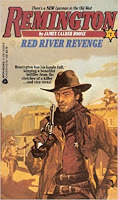 CHARLOTTE SHERMANWife of prolific Western writer Jory Sherman, Charlotte Sherman is credited to the seventh book in the Remington series under the house name, James Calder Boone. As Cort Martin she also wrote all the books in the Boltseries except the first—which was written by her husband.
CHARLOTTE SHERMANWife of prolific Western writer Jory Sherman, Charlotte Sherman is credited to the seventh book in the Remington series under the house name, James Calder Boone. As Cort Martin she also wrote all the books in the Boltseries except the first—which was written by her husband. OTHER WOMEN CONTRIBUTORSThe Hank Mitchum house name for the Stagecoach Station series was adopted by Kit Prate (three books), Michelle McQuaid (one book), and Amanda Cockrell Crowe(one book).
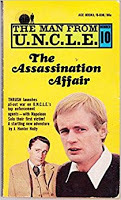 As John Holly, Joan Carol Holly got on the board writing one of the Ace original tie-in novels for The Man From U.N.C.L.E. series—The Assassination Affair.
As John Holly, Joan Carol Holly got on the board writing one of the Ace original tie-in novels for The Man From U.N.C.L.E. series—The Assassination Affair.Valerie Moolman was both editor and writer for numerous books in the Nick Carter Killmasterseries, while Linda Stewart and Dee Stuart each contributed two novels to the same series.
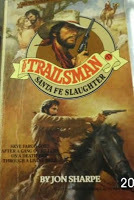 With her husband Ed, Martha Quillen contributed at least ten entries in the Trailsman series.Along with Jo Walpole (writing as Terry James), there are a number of Black Horse Westerns with female writers behind their pseudonyms. ******
With her husband Ed, Martha Quillen contributed at least ten entries in the Trailsman series.Along with Jo Walpole (writing as Terry James), there are a number of Black Horse Westerns with female writers behind their pseudonyms. ****** BELOW IS AN ADMITTEDLY INCOMPLETE LISTOF MEN'S ADVENTURE NOVELSATTRIBUTED TO WOMEN WRITERS...
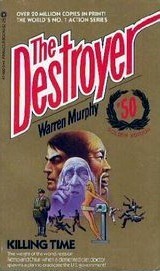 THE DESTROYER Molly Cochran:
THE DESTROYER Molly Cochran:Balance of Power / Spoils of War
Next of Kin / Dying Space
Skin Deep / Killing Time
Shock Value / Time Trial
Last Drop / Master's Challenge
Date with Death / The Eleventh Hour
NICK CARTER KILLMASTER Gayle Lynds:
The Mayan Connection/ Day of the Mahdi
Pursuit of the Eagle/ White Death
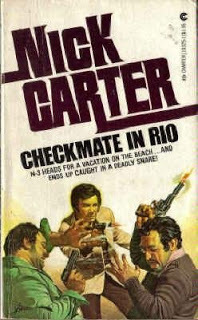 Valerie Moolman Run, Spy, Run (with Michael Avallone)
Valerie Moolman Run, Spy, Run (with Michael Avallone) The China Doll (with Michael Avallone)
Saigon (with Michael Avallone)
The Mind Poisoners (with Lionel White)
Checkmate in Rio / Safari for Spies
Fraulein Spy / A Bullet for Fidel
The 13th Spy / The Terrible Ones
Hanoi / The Weapon of Night
Linda Stewart: The Peking Dossier / The Jerusalem File
Marilyn Granbeck: Assignment: Intercept
Dee Stuart: Death Message: Oil 74-2 / Pamplona Affair
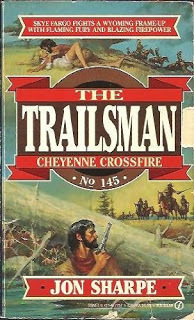 TRAILSMAN J. B. Keller:
TRAILSMAN J. B. Keller:Death Blow Trail / Cheyenne Crossfire
Coins of Death / Crowheart’s Revenge
Silver Maria / Silver River Conspiracy
Texas Triggers / Buffalo Guns
California Quarry / Ambush At Skull Pass
Ghost Ranch Massacre / Tornado Trail
Yukon Massacre / Colorado Carnage
Sutter’s Secret / Betrayal At El Dorado
Vengeance At Dead Man Rapids
Fort Range Conspiracy / Black Gulch Gamble
Salmon River Rage
Alice Duncan: Pecos Belle Brigade / California Crusader
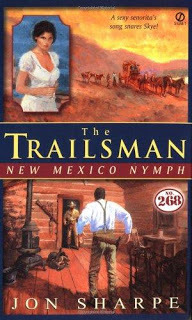 Ellen Recknor: St. Louis Sinners / New Mexico Nymph
Ellen Recknor: St. Louis Sinners / New Mexico Nymph Silver Mountain Slaughter / Kansas City Swindle
Martha Quillen (with Ed Quillen): Colorado Robber / Minnesota Missionary
Smoky Hell Trail / Utah Slaughter
Texas Hell Country / Cave of Death
Death’s Caravan / Desperate Dispatch
Mexican Massacre / Santa Fe Slaughter
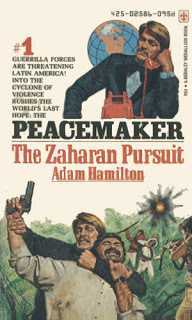 PEACEMAKER Marilyn Granbeck:
PEACEMAKER Marilyn Granbeck:The Zaharanrsuit / The Yashar Pursuit
The Xander Pursuit / The Wyss Pursuit
BLOOD
Marilyn Granbeck:
Blood / The Spandau Warrant
The Cat Cay Warrant
THE MAN FROM U.N.C.L.E. Joan Carol Holly:
The Assassination Affair
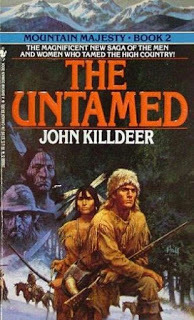 MOUNTAIN MAJESTYArdath Mayhar:The Untamed / Wild Country Wilderness Rendezvous
MOUNTAIN MAJESTYArdath Mayhar:The Untamed / Wild Country Wilderness RendezvousBlood Kin / Mountains West
The Far Horizon
POWELL’S ARMY Barbara Puechner:
Unchained Lightning
Apache Raiders
Mustang Warriors
REMINGTON Charlotte Sherman:
Red River Revenge
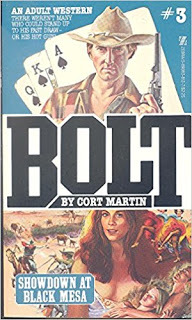 BOLTCharlotte Sherman:Dead Man's Bounty / Showdown At Black Mesa The Guns of Taos / Shootout At Santa Fe
BOLTCharlotte Sherman:Dead Man's Bounty / Showdown At Black Mesa The Guns of Taos / Shootout At Santa FeTombstone Honeypot / Rawhide Woman
Hard in the Saddle / Badman's Bordello
Bawdy House Showdown / The Last Bordello
The Hangtown Harlots / Montana Mistress
Virginia City Virgin / Bordello Backshooter
Hardcase Hussy / Lone Star Stud
Queen of Hearts / Palomino Stud
Six-Guns and Silk / Deadly Withdrawal
Climax Mountain / Hook Or Crook
Rawhide Jezebel / Not On the Warpath
Maverick Mistress
MAGGIE O’BANNEN
Jo Walpole:Days of Evil / Wanted: Dead
CODE ZERO
Dorothy Ayoob
Speedball
Deathride
Operation Barbary Coast
STAKEOUT SQUAD
Dorothy Ayoob
Line of Fire
Miami Heat
Color of Blood
Published on September 11, 2017 05:37
September 9, 2017
SOUTH AFRICAN PULP
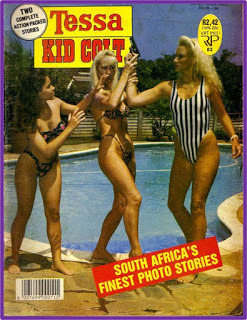
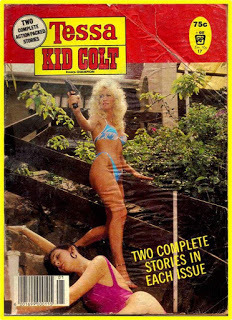 SOUTH AFRICAN PULP
SOUTH AFRICAN PULPLast year, I wrote a post examining the phenomenon of Lance Spearman ( CLICK HERE ), the superhero spy (known as the black James Bond) of a long running series of South African poesboekies or look books/photo books—a term coined for magazines featuring action photographs accompanied by comic strip style captions. These hybrid comics are relatively unknown in America. However in many other parts of the world, these comic mash-ups had a rabid following from the ‘60s to the late ‘80s. In Africa, poesboekies served as surrogate movies—a way to tell film-like stories—at a time when commercial African cinema had not yet been invented.
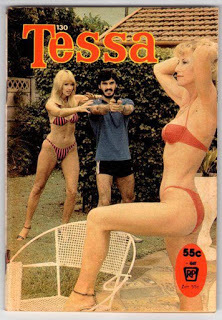 Recently, I came across an interesting short documentary on YouTube (
CLICK HERE
) celebrating South African poesboekies kultuur—which translates as pulp photo story culture. I also came across a trove of covers for a photo-book series named after its gorgeous title character, Tessa, a platinum blonde who battled evil the jungles of urban South Africa clad only in a bikini and high heels. Clashing with sinister looking individuals wearing bad suit and sunglasses, Tessa always came out on top, with not a strand of her bottled blonde hair out of place.
Recently, I came across an interesting short documentary on YouTube (
CLICK HERE
) celebrating South African poesboekies kultuur—which translates as pulp photo story culture. I also came across a trove of covers for a photo-book series named after its gorgeous title character, Tessa, a platinum blonde who battled evil the jungles of urban South Africa clad only in a bikini and high heels. Clashing with sinister looking individuals wearing bad suit and sunglasses, Tessa always came out on top, with not a strand of her bottled blonde hair out of place. 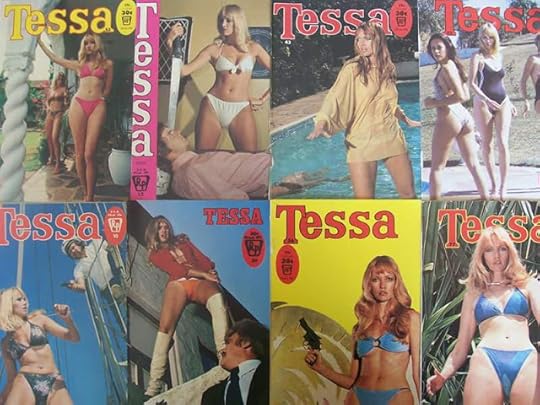 To her ardent continent-wide fans, Tessa, the bikini-clad, Karate kicking government agent, was akin to a goddess. Every 30,000 copy issue of Tessa sold out almost instantaneously on the newsstands—creating a lucrative secondhand market. Those 30,000 copies in today’s Internet savvy market would equal numbers to put the Kardashian’s Twitter followers to shame.
To her ardent continent-wide fans, Tessa, the bikini-clad, Karate kicking government agent, was akin to a goddess. Every 30,000 copy issue of Tessa sold out almost instantaneously on the newsstands—creating a lucrative secondhand market. Those 30,000 copies in today’s Internet savvy market would equal numbers to put the Kardashian’s Twitter followers to shame.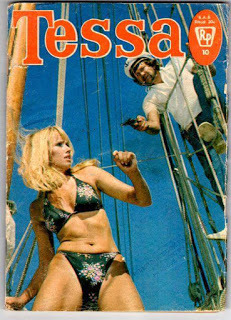 The South African publishing company Republican Press were the low-budget force behind the phenomenon of the photo comics Tessa and Kid Colt, as well as the Playboy knockoff Scope. At its zenith, Republican Press was printing 20 different poesboekies a month. Grafting Western influenced literary myths onto African settings,
The South African publishing company Republican Press were the low-budget force behind the phenomenon of the photo comics Tessa and Kid Colt, as well as the Playboy knockoff Scope. At its zenith, Republican Press was printing 20 different poesboekies a month. Grafting Western influenced literary myths onto African settings, 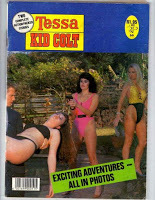
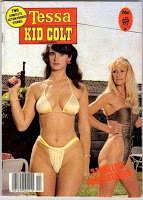
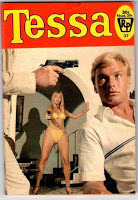 The actors were mostly locals from working-class neighborhoods. While the top poesboekie models were paid 25 to 30 rand a day—which at the time was a lucrative way to pay your rent—most appearance fees were negligible. The recognizable main male actors were generally consider eccentric, hard-living, womanizers. Working quickly, an entire book could be shot in one to three days depending on the complexity of the simple sets.
The actors were mostly locals from working-class neighborhoods. While the top poesboekie models were paid 25 to 30 rand a day—which at the time was a lucrative way to pay your rent—most appearance fees were negligible. The recognizable main male actors were generally consider eccentric, hard-living, womanizers. Working quickly, an entire book could be shot in one to three days depending on the complexity of the simple sets. 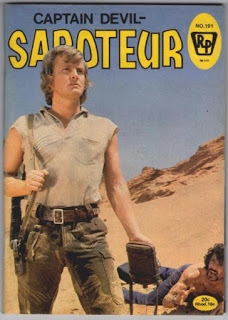
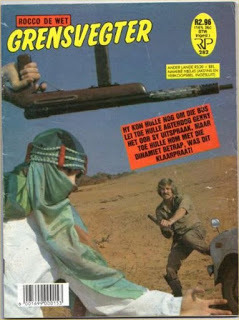
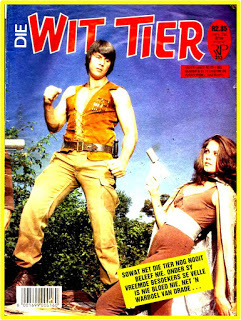
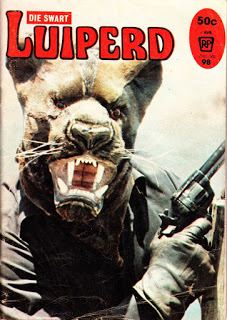 There were also army heroes—Swart Luiperd, Wit Tier, Kaptein Duiwel, Grensvegter (Black Leopard, White Tiger, Captain Devil, Grantsman) and others. They were most often depicted out in the jungle clutching their wooden machine guns, killing cigar smoking Cuban clones. Almost always, the villains held the proverbial disheveled damsel in distress captive after her convoy/aircraft/helicopter/hospital was invaded/crashed/broke down. The real South African soldiers who read these outrageous tales figured they could go back to civilian life if only these heroes existed outside their fervent imaginations.
There were also army heroes—Swart Luiperd, Wit Tier, Kaptein Duiwel, Grensvegter (Black Leopard, White Tiger, Captain Devil, Grantsman) and others. They were most often depicted out in the jungle clutching their wooden machine guns, killing cigar smoking Cuban clones. Almost always, the villains held the proverbial disheveled damsel in distress captive after her convoy/aircraft/helicopter/hospital was invaded/crashed/broke down. The real South African soldiers who read these outrageous tales figured they could go back to civilian life if only these heroes existed outside their fervent imaginations.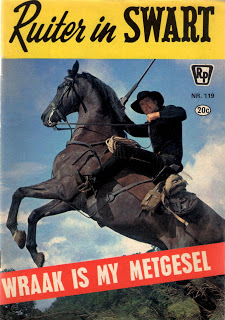 Poesboekie cowboy heroes were also featured regularly. Danie van Rensburg was Ruiter in the Swart (Rider In Black), one of the first photo books published by Republican Press in 1966. Ruiter in the Swart became arguably the most popular of the cowboy poesboekies.
Poesboekie cowboy heroes were also featured regularly. Danie van Rensburg was Ruiter in the Swart (Rider In Black), one of the first photo books published by Republican Press in 1966. Ruiter in the Swart became arguably the most popular of the cowboy poesboekies. The storyline focused on the character of Ben riding across the 1880s Lowveld—a low-lying subtropical climate where broad-leaved trees and thorn trees co-exist in relatively open woodland, interspersed with long grass and lots of game. After his son is kidnapped, Ben makes it his life's ambition to root out evil while searching for his son.
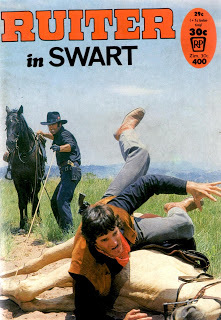 When the series ended after 17 years and 491 issues, Ben's son was still missing, but many evil-doers had been put down. In 2012, the character was still fondly remembered. Ruiter in Swart Productions produced a film version, which brought Danie van Rensburg to his most popular role 30 years after the last print version.
When the series ended after 17 years and 491 issues, Ben's son was still missing, but many evil-doers had been put down. In 2012, the character was still fondly remembered. Ruiter in Swart Productions produced a film version, which brought Danie van Rensburg to his most popular role 30 years after the last print version. 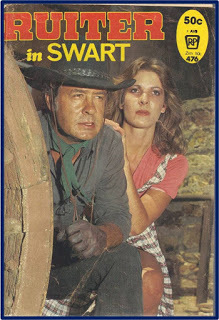 In the movie version, Ben is retired from the ZARP (Zuid Afrikaanse Republiek Polisie). When evidence his long lost son, Eben, is leading a gang of cattle rustler, Ruiter in Swart has no hesitation in donning his famous black outfit, strapping on his gun belt, saddling his black stallion, and setting out in pursuit.
In the movie version, Ben is retired from the ZARP (Zuid Afrikaanse Republiek Polisie). When evidence his long lost son, Eben, is leading a gang of cattle rustler, Ruiter in Swart has no hesitation in donning his famous black outfit, strapping on his gun belt, saddling his black stallion, and setting out in pursuit.In a real world twist, Ruiter in Swart’s manly star, Danie van Rensburg, was married to Erna van der Westhuisen, the sexy lady who played Tessa.
Etienne van der Westhuizen starred as Kid Die Swerwer (Kid Colt), a poesboekie cowboy who would share pages with Tessa as the popularity of the photo book declined. Born in a province of South Africa known as Free State, Etienne van der Westhuizen was an outstanding college rugby player.
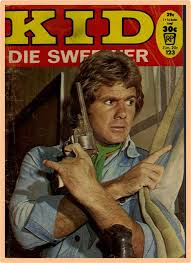 While sitting on the beach when the weather was to bad to go fishing, he was approached by a poesboekie scout who asked if he was interested in playing a part in a Western photo story. Fortunately for Etienne, he could ride horses and do stunt work. After the first week, he was hired to work on a regular basis.
While sitting on the beach when the weather was to bad to go fishing, he was approached by a poesboekie scout who asked if he was interested in playing a part in a Western photo story. Fortunately for Etienne, he could ride horses and do stunt work. After the first week, he was hired to work on a regular basis. 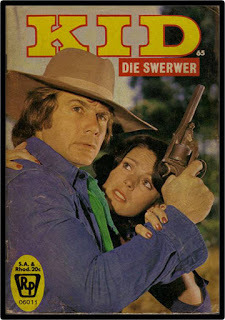 Many of the cowboy poesboekies where shot at an old monastery, which was the perfect backdrop for a Western. Etienne was constantly riding horses for every issue only to have to fall off them again and again to be sure of capturing the right photo. Another Western set were the scrub bushes and sand dunes in an area around the Umgababa. The dunes were so steep the horses couldn’t be used. However, if a script called for desert sequences, Etienne and the other actors had to create their scenes on the difficult slopes. Etienne eventually became an organizer—taking charge of photo stories and organizing the wardrobe, changes of clothing, and continuity.
Many of the cowboy poesboekies where shot at an old monastery, which was the perfect backdrop for a Western. Etienne was constantly riding horses for every issue only to have to fall off them again and again to be sure of capturing the right photo. Another Western set were the scrub bushes and sand dunes in an area around the Umgababa. The dunes were so steep the horses couldn’t be used. However, if a script called for desert sequences, Etienne and the other actors had to create their scenes on the difficult slopes. Etienne eventually became an organizer—taking charge of photo stories and organizing the wardrobe, changes of clothing, and continuity.Of his time starring as Kid Die Swerwer, Etienne is quoted as saying:
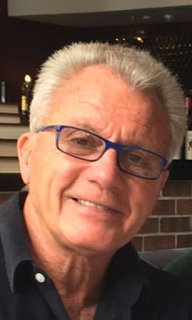 Friends from yesteryear still call me Kid—but back then it was very much a name. At one stage, right at the beginning of the book, it was very hard to sit in a restaurant and not have kids point at you and have people ask whether you were that guy from the book. At the end of the day, I thought of myself more as a stunt rider than anything else, but I got to meet lovely people from all walks of life. Whenever we needed extras, we’d go down to the beach and chat to folks—usually backpackers from Australia or New Zealand—and offer them bit parts. It was great fun.
Friends from yesteryear still call me Kid—but back then it was very much a name. At one stage, right at the beginning of the book, it was very hard to sit in a restaurant and not have kids point at you and have people ask whether you were that guy from the book. At the end of the day, I thought of myself more as a stunt rider than anything else, but I got to meet lovely people from all walks of life. Whenever we needed extras, we’d go down to the beach and chat to folks—usually backpackers from Australia or New Zealand—and offer them bit parts. It was great fun.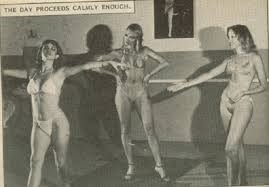 The Hang Fire Booksblog features a post (
CLICK HERE
) with an account from Dianne, a model who was often featured as a secondary character in the Tessa books...
The Hang Fire Booksblog features a post (
CLICK HERE
) with an account from Dianne, a model who was often featured as a secondary character in the Tessa books...Most of the filming was done at Republican Press in Mobeni, Durban. They had a separate section which was used for photo stories and they had various sets arranged—a jail, operating theatre, doctors office, etc.
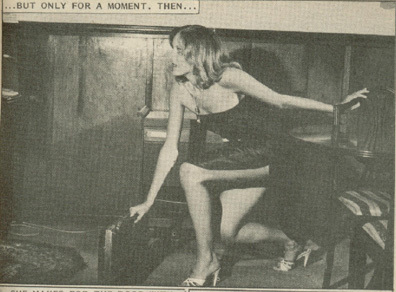 On the whole, it only took a morning to shoot the entire book. We used to get there by 0830 and were finished between 1200 and 1400 depending on your part in the book. We would bring three day outfits, one evening outfit, and a bikini. All of us became quite adept at changing in the back of the Combi [a slang word for the VW van used on sets as a trailer for the actors]. It was a good laugh to go through the books when they were published and see all the mistakes that were made!
On the whole, it only took a morning to shoot the entire book. We used to get there by 0830 and were finished between 1200 and 1400 depending on your part in the book. We would bring three day outfits, one evening outfit, and a bikini. All of us became quite adept at changing in the back of the Combi [a slang word for the VW van used on sets as a trailer for the actors]. It was a good laugh to go through the books when they were published and see all the mistakes that were made!
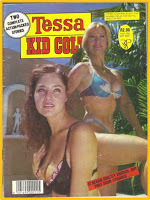
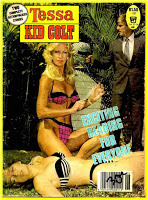 These mass produced popular culture pulps, along with many similar poesboekies, were considered disposable at the time of their publication. Today, they have become lovingly remembered collectors items and even a literary history of their times.
These mass produced popular culture pulps, along with many similar poesboekies, were considered disposable at the time of their publication. Today, they have become lovingly remembered collectors items and even a literary history of their times.
Published on September 09, 2017 17:02
August 22, 2017
STEVE HOLLAND—THE FACE OF A HERO
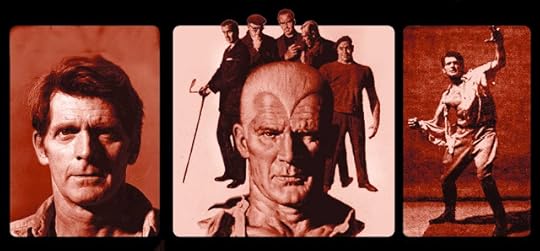 STEVE HOLLAND—THE FACE OF A HERO
STEVE HOLLAND—THE FACE OF A HERO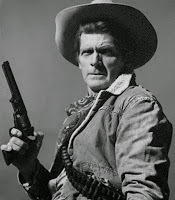 Known as The Face That Launched A Thousand Paperbacks, artists’ model Steve Holland embodied and defined the words rough, tough, manly, and heroic. In the ‘70s, Steve Holland’s skill for striking action poses made him the first, and often only model choice, for the top paperback cover illustration artists of the day. When editors insisted their artists use different cover models, the results were never as creative or effective. As a result, sales of their hero centric paperbacks plummeted when Holland’s presence didn’t grace the covers.
Known as The Face That Launched A Thousand Paperbacks, artists’ model Steve Holland embodied and defined the words rough, tough, manly, and heroic. In the ‘70s, Steve Holland’s skill for striking action poses made him the first, and often only model choice, for the top paperback cover illustration artists of the day. When editors insisted their artists use different cover models, the results were never as creative or effective. As a result, sales of their hero centric paperbacks plummeted when Holland’s presence didn’t grace the covers.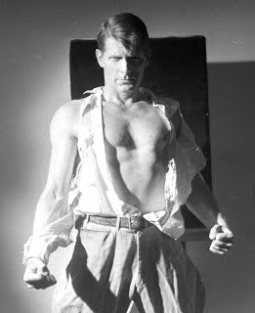 Holland’s unique understanding of how the human body moved and position itself in any action related scenario—exaggerated pulp heroics, military combat, galloping on horseback, murder minded men’s adventure vigilantes, firing weapons, or having his flesh ripped by weasels—made him an unmatched phenomenon. Coupled with the craggy lines of his uber masculine features, Holland became the dominant force in the world of paperback cover paintings. His instantly identifiable image was also ripped-off as many times if not more than it was used with authorization.
Holland’s unique understanding of how the human body moved and position itself in any action related scenario—exaggerated pulp heroics, military combat, galloping on horseback, murder minded men’s adventure vigilantes, firing weapons, or having his flesh ripped by weasels—made him an unmatched phenomenon. Coupled with the craggy lines of his uber masculine features, Holland became the dominant force in the world of paperback cover paintings. His instantly identifiable image was also ripped-off as many times if not more than it was used with authorization.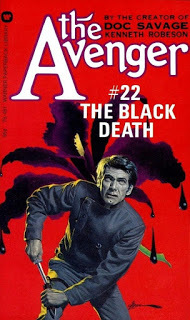 Doc Savage, The Avenger, The Sharpshooter, The Penetrator, and a hundred other paperback heroes all display the same firm jawline, deep set steely eyes, slightly cruel mouth, and imposing physical frame composed of twisted muscles and iron. He looked good in cavalry jodhpurs and boots, a ripped shirt, a skintight hero disguise, or anything else dragged from a costumer’s closet. Holland radiated machismo.
Doc Savage, The Avenger, The Sharpshooter, The Penetrator, and a hundred other paperback heroes all display the same firm jawline, deep set steely eyes, slightly cruel mouth, and imposing physical frame composed of twisted muscles and iron. He looked good in cavalry jodhpurs and boots, a ripped shirt, a skintight hero disguise, or anything else dragged from a costumer’s closet. Holland radiated machismo.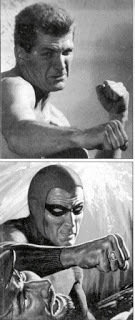 Holland had minor successes with an acting career. He was Flash Gordon for a quickly and cheaply produced early television series. He had minor roles in summer stock and other theatre productions. None of these roles would lead to anything anywhere near the pinnacle Holland would reach as a cover model. When his posing work began to pay far more than his acting work and provided a steady demand for his services, Holland abandoned acting to pursue his true calling.
Holland had minor successes with an acting career. He was Flash Gordon for a quickly and cheaply produced early television series. He had minor roles in summer stock and other theatre productions. None of these roles would lead to anything anywhere near the pinnacle Holland would reach as a cover model. When his posing work began to pay far more than his acting work and provided a steady demand for his services, Holland abandoned acting to pursue his true calling.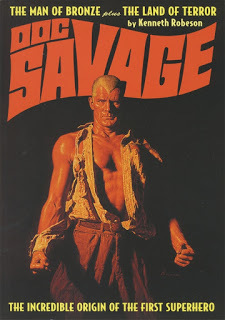 Revered American artist James Bama famously used Holland as the model for the series of the now iconic paperback covers he painted for the Doc Savage—the Man of Bronze—adventures, which were published by Bantam. Bama also used Holland as the model for his first paperback cover commission A Bullet For Billy The Kid.
Revered American artist James Bama famously used Holland as the model for the series of the now iconic paperback covers he painted for the Doc Savage—the Man of Bronze—adventures, which were published by Bantam. Bama also used Holland as the model for his first paperback cover commission A Bullet For Billy The Kid.Bama’s style of illustration was known as photo-realistic. He would take numerous photos of his model—in many cases Steve Holland—to use as a guide while creating a painting with the look and feel of a photograph. Bamma was so enthralled with Steve Holland’s understanding of how to use light and shadow to dramatically embody his poses, he referred to Holland as the world’s greatest male model. Nobody has ever argued with the moniker.
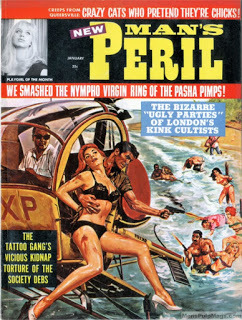 Before Holland became a one man paperback cover sensation, he first conquered the world of Men’s Adventure Magazine covers in similar fashion. The outrageous yet brilliant cover paintings on the Men’s Adventure Magazines were steroided versions of the lurid scenes and garish colors from the original pulp magazines. Illustration artists like Bruce Minney, Mel Crair, and Norm Eastman (who often used himself as the model for villains and other characters) fueled these covers with explosions of sex and sadism. And Steve Holland’s visage was splashed across a literally uncountable number of them.
Before Holland became a one man paperback cover sensation, he first conquered the world of Men’s Adventure Magazine covers in similar fashion. The outrageous yet brilliant cover paintings on the Men’s Adventure Magazines were steroided versions of the lurid scenes and garish colors from the original pulp magazines. Illustration artists like Bruce Minney, Mel Crair, and Norm Eastman (who often used himself as the model for villains and other characters) fueled these covers with explosions of sex and sadism. And Steve Holland’s visage was splashed across a literally uncountable number of them.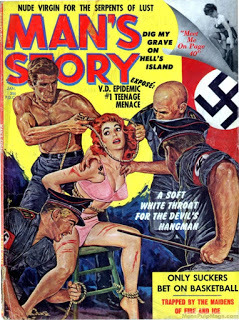 Often, Holland would be featured along with his female counterpart, the beautiful Eva Lynd. The duo rescued, tortured, or chased each other—interchanging roles as damsels/hunks in distress, evil sadists, or brave heroes to fit the needs of the interior stories on hundreds of Men’s Adventure Magazine covers and in other illustrations.
Often, Holland would be featured along with his female counterpart, the beautiful Eva Lynd. The duo rescued, tortured, or chased each other—interchanging roles as damsels/hunks in distress, evil sadists, or brave heroes to fit the needs of the interior stories on hundreds of Men’s Adventure Magazine covers and in other illustrations. 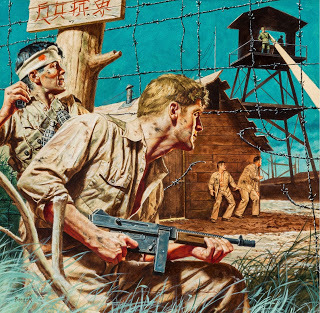 On cover after cover, Holland was the hard-bitten Marine rescuing a gorgeous, bikini bottom clad woman, her long hair artfully covering her other voluptuous charms, from the clutches of Nazi sadists; the Mauser wielding American agent about to save provocatively posed, scantily clad, battlefield nurses from sexual slavery; the deadly commando knifing Japanese sentries to liberate half naked, high heel wearing, blondes with enhanced attributes, from a POW camp (don’t ask how they got there); the brave, bare-chested American soldier about to be tortured in incredibly ingenious ways; and any other crazed scenario imaginable.
On cover after cover, Holland was the hard-bitten Marine rescuing a gorgeous, bikini bottom clad woman, her long hair artfully covering her other voluptuous charms, from the clutches of Nazi sadists; the Mauser wielding American agent about to save provocatively posed, scantily clad, battlefield nurses from sexual slavery; the deadly commando knifing Japanese sentries to liberate half naked, high heel wearing, blondes with enhanced attributes, from a POW camp (don’t ask how they got there); the brave, bare-chested American soldier about to be tortured in incredibly ingenious ways; and any other crazed scenario imaginable.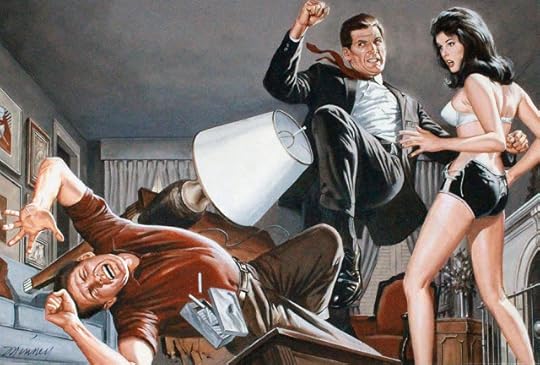 It was common for Holland to be on the covers of two or even there different Men’s Adventure Magazines in the same month. Whether fighting off crazed wild animals of dubious species, taking on a pack of outlaw bikers in the subway, or leading a team of frogmen on a desperate submarine sabotage assignment, Holland made you believe he was capable of taking on any dangerous assignment, or escaping from threatened torments without breaking a sweat.
It was common for Holland to be on the covers of two or even there different Men’s Adventure Magazines in the same month. Whether fighting off crazed wild animals of dubious species, taking on a pack of outlaw bikers in the subway, or leading a team of frogmen on a desperate submarine sabotage assignment, Holland made you believe he was capable of taking on any dangerous assignment, or escaping from threatened torments without breaking a sweat.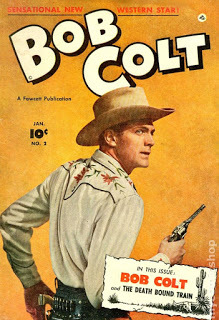 Paperbacks and Men’s Adventure Magazines were not the only publishing mediums to take advantage of Holland’s masculine presence. He appeared on comic book covers such as Bob Colt, Magnus, Robot Fighter 4000 A.D., The Phantom—The Ghost Who Walks, and many others.
Paperbacks and Men’s Adventure Magazines were not the only publishing mediums to take advantage of Holland’s masculine presence. He appeared on comic book covers such as Bob Colt, Magnus, Robot Fighter 4000 A.D., The Phantom—The Ghost Who Walks, and many others.Fashion and similar advertising campaigns, along with posters for B-Movies such as Latitude Zero, Sahara Cross, or A Taste For Killing, all looked to the manliness of Steve Holland to push product. If he was around today there is no doubt his avatar would reign over the world of high tech gaming.
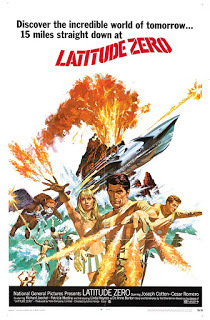 However, the ‘70s explosion of paperback originals and reprints of established pulp hero adventures made Holland a superstar—his image impossible to escape even today. The Men’s Adventure Magazines made Holland familiar to it’s wide, but niche audience. However, the societal mores demanded Men’s Adventure Magazines be hidden down the side of dad's armchair, or kept in dark corners of garages next to hidden stacks of Playboys.
However, the ‘70s explosion of paperback originals and reprints of established pulp hero adventures made Holland a superstar—his image impossible to escape even today. The Men’s Adventure Magazines made Holland familiar to it’s wide, but niche audience. However, the societal mores demanded Men’s Adventure Magazines be hidden down the side of dad's armchair, or kept in dark corners of garages next to hidden stacks of Playboys. While some of the top tier Men's Adventure Magazines (such as Argosy) were prominently displayed on the newstands of the day, many of the more salacious titles were consigned to the back racks of the lowest tier lest sensibilities of the less manly be offended.
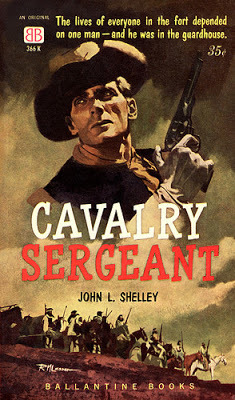 Paperback covers exposed Holland’s image to the rest of the world. On every drugstore spinner rack across the country, Holland was Doc Savage, The Avenger, The Spider, The Executioner, Jason Striker: Master of martial Arts, Western series hero Buchanan, The Phantom, The Penetrator, The Man From O.R.G.Y. and an infinite number of mercenaries, cops, cowboys, crooks, action series characters and standalone heroes.
Paperback covers exposed Holland’s image to the rest of the world. On every drugstore spinner rack across the country, Holland was Doc Savage, The Avenger, The Spider, The Executioner, Jason Striker: Master of martial Arts, Western series hero Buchanan, The Phantom, The Penetrator, The Man From O.R.G.Y. and an infinite number of mercenaries, cops, cowboys, crooks, action series characters and standalone heroes.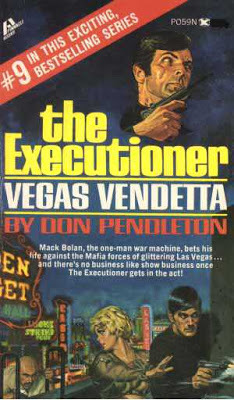
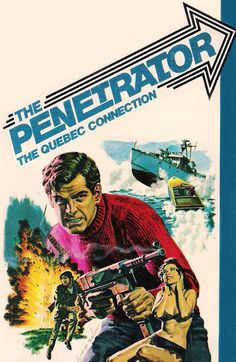 In 1992, Holland retired to pursue his passion for painting after posing for a last few Doc Savage covers. He passed away in 1997. He was 72 years old. To this day and into the foreseeable future, even casual collectors of Men’s Adventure Magazines or paperback action series can’t help but have examples of Steve Holland action covers on their shelves. Sylvester Stallone, Chuck Norris, Jason Statham, Dwayne The RockJohnson, and all the other kick-ass pretty boys are pretenders to the throne of the Ultimate Man Of Action. Steve Holland remains the now and forever king—Long live the king...
In 1992, Holland retired to pursue his passion for painting after posing for a last few Doc Savage covers. He passed away in 1997. He was 72 years old. To this day and into the foreseeable future, even casual collectors of Men’s Adventure Magazines or paperback action series can’t help but have examples of Steve Holland action covers on their shelves. Sylvester Stallone, Chuck Norris, Jason Statham, Dwayne The RockJohnson, and all the other kick-ass pretty boys are pretenders to the throne of the Ultimate Man Of Action. Steve Holland remains the now and forever king—Long live the king...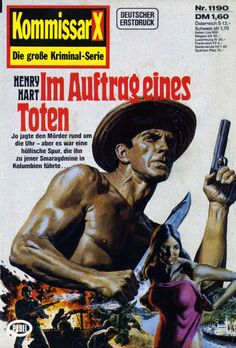
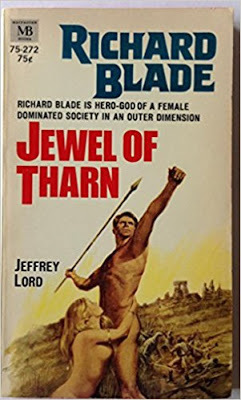 FOR MORE INFORMATION ON STEVE HOLLAND AND EVERYONE AND EVERYTHING ELSE CONNECTED TO THE MEN’S ADVENTURE MAGAZINES CLICK HERE
FOR MORE INFORMATION ON STEVE HOLLAND AND EVERYONE AND EVERYTHING ELSE CONNECTED TO THE MEN’S ADVENTURE MAGAZINES CLICK HERE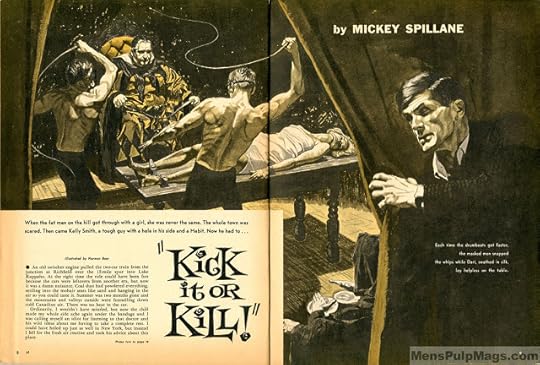 FOR A LOOK AT MORE STEVE HOLLAND COVERS CLICK HERE
FOR A LOOK AT MORE STEVE HOLLAND COVERS CLICK HERE***Thanks to Men's Adventure Magazine czar Bob Deis for his input while operating from his hidden lair behind the pages of his Men's Pulp Magazines website...
Published on August 22, 2017 17:46
August 20, 2017
WHITLATCH’S ENIGMA
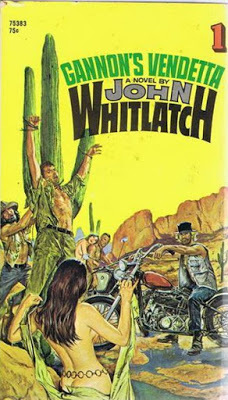
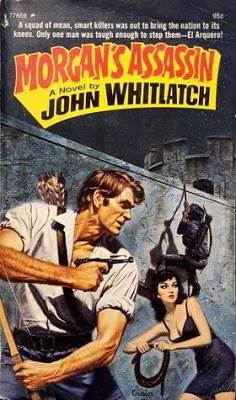 WHITLATCH’S ENIGMA
WHITLATCH’S ENIGMAJohn Whitlatch is an author whose name pops up regularly within men’s adventure series genre circles. Between 1969 and 1976, Whitlatch wrote eleven action novels, the first ten of which were published with a series of stunning covers. Lurid and garish, featuring outlaw bikers, big breasted babes in jeopardy, and tough heroes out for revenge, the covers of Whitlatch’s novels could just as easily have graced the covers of any of the titillating Men’s Adventure Magazines of the day.
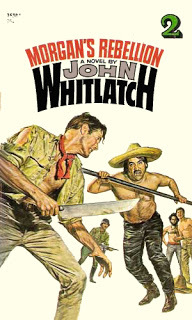 In actuality, the stunning covers of Whitlatch’s books were painted by regular Men’s Adventure Magazine artists, including Norm Eastman (Gannon’s Vendetta, Lafitte's Legacy, Tanner's Lemming, and The Judas Goat) and Mel Crair (Morgan's Rebellion, Stunt Man's Holiday and Morgan's Assassin). Men’s Adventure Magazine top model Steve Holland—who is also the face of a thousand paperback heroes—appears on several of the covers, adding to their collectability. Unfortunately, Whitlatch’s last novel, Gannon’s Line, did not receive a similar instantly collectible cover Instead, it was given a generic instantly forgettable illustration.
In actuality, the stunning covers of Whitlatch’s books were painted by regular Men’s Adventure Magazine artists, including Norm Eastman (Gannon’s Vendetta, Lafitte's Legacy, Tanner's Lemming, and The Judas Goat) and Mel Crair (Morgan's Rebellion, Stunt Man's Holiday and Morgan's Assassin). Men’s Adventure Magazine top model Steve Holland—who is also the face of a thousand paperback heroes—appears on several of the covers, adding to their collectability. Unfortunately, Whitlatch’s last novel, Gannon’s Line, did not receive a similar instantly collectible cover Instead, it was given a generic instantly forgettable illustration.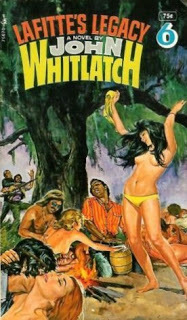 While the covers of Whitlatch’s books are often the catalyst for men’s adventure readers to buy and collect them, the writing between the covers is uniformly terrific. While definitely in sync with the attitudes and mores of the time period in which they were written, Whitlatch’s tales of every day guys caught up in deadly circumstances never failed to thrill. A Whitlatch hero is a man pushed beyond the reasonable boundaries of civilization and is forced to find a core of inner strength to overcome overwhelming odds—in other words, a guy who you can unabashedly root for as he takes on outlaw motorcycle gangs, voodoo cults, tin-pot Latin dictators, sadistic Japanese troops in the Pacific Theater, Renegade Indians, and other megalomaniac villains.
While the covers of Whitlatch’s books are often the catalyst for men’s adventure readers to buy and collect them, the writing between the covers is uniformly terrific. While definitely in sync with the attitudes and mores of the time period in which they were written, Whitlatch’s tales of every day guys caught up in deadly circumstances never failed to thrill. A Whitlatch hero is a man pushed beyond the reasonable boundaries of civilization and is forced to find a core of inner strength to overcome overwhelming odds—in other words, a guy who you can unabashedly root for as he takes on outlaw motorcycle gangs, voodoo cults, tin-pot Latin dictators, sadistic Japanese troops in the Pacific Theater, Renegade Indians, and other megalomaniac villains.Whitlatch’s books are straightforward contemporary actioneers. Even when writing a Western (Iron Shirt) or a WWII Dirty Dozen style tale (The Judas Goat), the narratives are straight out of the men’s adventure genre. This is not to say they are cookie cutter or by the numbers plots. Whitlatch’s writing elevates the tropes of the genre with excellent action scenes. His heroes are not supermen, but rugged individuals who face their fears and have the courage to not lay down and die.
For many years Whitlatch himself remained an total enigma. When asked about Whitlatch, regular genre resources and gurus were forced to shrug their shoulders and admit to their mystification at the lack of information.
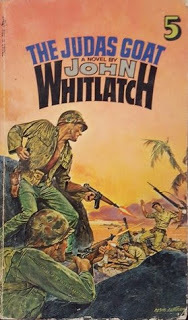 Usually, this little information about an author would indicate the use of a house owned pseudonym, with a number of authors penning the tales. But, this doesn’t appear to be the case with Whitlatch. Having read all eleven novels, the distinctive tempo and sentence structure make it clear they were written by the same person.
Usually, this little information about an author would indicate the use of a house owned pseudonym, with a number of authors penning the tales. But, this doesn’t appear to be the case with Whitlatch. Having read all eleven novels, the distinctive tempo and sentence structure make it clear they were written by the same person.About twenty years or more ago, I tried tracking Whitlatch through his publisher. I was put in touch with Whitlatch’s agent who informed me Whitlatch was deceased. He did, however, provide me with a contact number for his family, warning me they would probably not want to be interviewed.
I eventually made contact with Whitlatch’s sister in Arizona, but while polite, she refused to impart any information. A strange situation, especially coupled with a tid-bit from mystery historian Al Hubin, which noted there had been no copyright renewals on Whitlatch’s titles. This raised the odd possibility of Whitlatch or his work being seen as an embarrassment to his family.
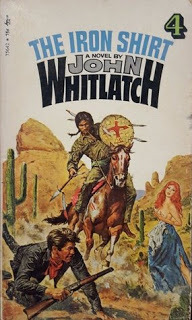 My introduction to Whitlatch originally came through his second published title, Morgan’s Rebellion. This was a great adventure tale. The all-American everyman Jamey Morgan finds himself falsely imprisoned in Central America. Desperate and alone, he takes it upon himself to escape, rally the scattered rebel forces, and overthrow the corrupt regime in order to get his life back and revenge on his wife and business partner.
My introduction to Whitlatch originally came through his second published title, Morgan’s Rebellion. This was a great adventure tale. The all-American everyman Jamey Morgan finds himself falsely imprisoned in Central America. Desperate and alone, he takes it upon himself to escape, rally the scattered rebel forces, and overthrow the corrupt regime in order to get his life back and revenge on his wife and business partner.This was great stuff! Morgan was a cool character with his archery background and his righteous American indignation. Whitlatch is hardly politically correct and he wears the Mad Man style male chauvinist label proudly—definitely a product of his time—but the guy could write a rousing adventure
In 2009, I wrote about Whitlatch in a Forgotten Books post for my blog. At the time, in response to a blog post of his own, my buddy and prolific writer James Reasoner said, “You have to love the Internet.” In James’ case, his own blog post regarding a specific hardboiled author generated unexpected contact from one of the author’s surviving relatives.
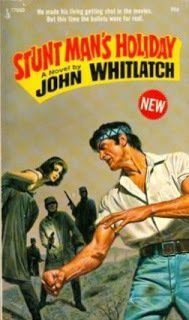 In my case, several months after my post bemoaning the complete lack of information about John Whitlatch—beyond his novels and those lurid covers—I received a surprise email. It was from Bob Miller, a friend and former co-worker of Whitlatch’s who had somehow come across my original Whitlatch post. He offered to share information about the elusive author, whom he stated was a down-to-earth nice guy with a good sense of humor. I immediately scrambled to dial the provided phone and quickly found myself chatting with my informant.
In my case, several months after my post bemoaning the complete lack of information about John Whitlatch—beyond his novels and those lurid covers—I received a surprise email. It was from Bob Miller, a friend and former co-worker of Whitlatch’s who had somehow come across my original Whitlatch post. He offered to share information about the elusive author, whom he stated was a down-to-earth nice guy with a good sense of humor. I immediately scrambled to dial the provided phone and quickly found myself chatting with my informant. Bob Miller told me he worked with Whitlatch in the 1960s when they were both claims adjusters for an insurance company working out of an office on Gower Street in Hollywood. Bob remained friends with Whitlatch, and was an ardent reader of his novels, until Whitlatch died in the late 1970s.
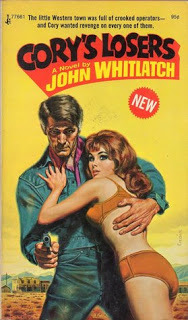 Apparently, Whitlatch was a force in the insurance business. He eventually became the head claims adjuster for All-State Insurance, working out of the company’s headquarters on Wilshire Boulevard in LA. Reportedly, he had a large, framed, picture of the All-State HQ building in Chicago hung on the wall behind his desk. The picture had a hand-drawn arrow pointing to one specific window in the building, which Whitlatch claimed was the office of the idiot I work for.
Apparently, Whitlatch was a force in the insurance business. He eventually became the head claims adjuster for All-State Insurance, working out of the company’s headquarters on Wilshire Boulevard in LA. Reportedly, he had a large, framed, picture of the All-State HQ building in Chicago hung on the wall behind his desk. The picture had a hand-drawn arrow pointing to one specific window in the building, which Whitlatch claimed was the office of the idiot I work for.While working as a claims adjuster, Whitlatch also attempted to branch out into private business. For several years, he operated a self-service laundry on Ventura Boulevard—in the San Fernando Valley—with his wife, Geraldine. However, the business was forced into bankruptcy when long-term street repairs closed down easy access to the building.
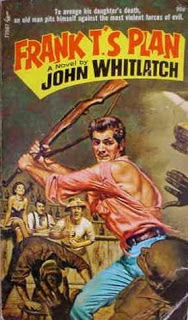 Crippled with a bad limp, Whitlatch didn’t let his physical infirmities keep him down. Miller remembers Whitlatch’s visits to the ranch where Miller’s father-in-law trained and bred horses. Whitlatch always managed to get around and showed an interest in everything.
Crippled with a bad limp, Whitlatch didn’t let his physical infirmities keep him down. Miller remembers Whitlatch’s visits to the ranch where Miller’s father-in-law trained and bred horses. Whitlatch always managed to get around and showed an interest in everything.During the time of his visits to the stables, Whitlatch began writing spec movie scripts. Miller’s father-in-law had contacts in the movie industry via several of the horse owners for whom he bred and trained. He allowed Whitlatch access to those contacts and, while Whitlatch never sold a script, he received encouragement and praise for his writing.
On one stable visit, Whitlatch witnessed Miller’s father-in-law putting Vicks Vapor Rub in a mare’s nose in order to get her to accept a foal that wasn’t hers. The Vicks worked to distort the mare’s olfactory senses so she couldn’t tell the foal wasn’t her own. Whitlatch was to later use the scene in one of his novels.
A perfectionist when it came to insurance work, Whitlatch was a taskmaster—never letting correspondence or reports leave the office until they were letter perfect. But while he found insurance work financially rewarding, he longed to quit and write full time.
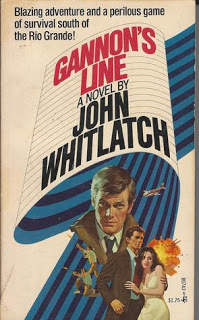 Miller remembers the day Whitlatch called him full of excitement. He had just sold his first two novels. Pocket Books had given him a contract for two of his completed manuscripts and planned to publish both novels simultaneously—a first for the publishing house.
Miller remembers the day Whitlatch called him full of excitement. He had just sold his first two novels. Pocket Books had given him a contract for two of his completed manuscripts and planned to publish both novels simultaneously—a first for the publishing house.Whitlatch eventually quit All-State to pursue his writing career. He had a handful of other novels published, but there was bad news on the horizon. Two years later, Miller received a phone call from his friend. Whitlatch told Miller he had been diagnosed with a brain tumor and had been given six month to two years to live.
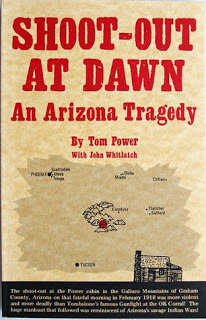 Whitlatch’s final book, Shoot-Out At Dawn, was a non-fiction account of the deadly events at a remote Southern Arizona cabin in 1918. The book was written with Tom Power, one of the survivors of the clash. Whitlatch died shortly after it was published by Phoenix Books in 1981.
Whitlatch’s final book, Shoot-Out At Dawn, was a non-fiction account of the deadly events at a remote Southern Arizona cabin in 1918. The book was written with Tom Power, one of the survivors of the clash. Whitlatch died shortly after it was published by Phoenix Books in 1981.From other sources , it appears Whitlatch’s wife died sometime around 2005. The couple had no children. Clearly, Whitlatch will remain an enigma, but thanks to Bob Miller, those of us who have admired Whitlatch’s novels were finally given a glimpse into his background.
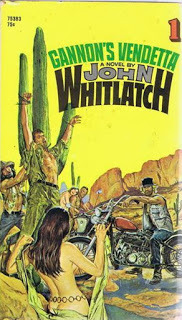 GANNON'S VENDETTA
GANNON'S VENDETTA Do not forget, gentlemen—violence is the only thing they understand. If in doubt, kill.
Recalling with hatred all the blood and pain these cycle creeps had caused him, Gannon described his enemy to the men who had come to help him. The animals on the hopped-up Harleys had raped Gannon's wife, torched his house, and then—after working him over—dumped him in the desert to die. They never expected Gannon to come out alive. This was the end of the long hunt--high noon at midnight. Gannon had followed the rat pack deep into Mexico. And now he was ready to do battle—their style.
 GANNON'S LINE
GANNON'S LINE John Gannon had settled into the life he wanted as foreman of the Holguin Rancho, south of Sonora. But powerful people in Washington had singled him out to lead a band of men and horses into the scorching Baja desert. His mission: to locate in that inferno of sand and sun the secret base of an espionage ring—and to crush the sadistic genius who masterminded it.
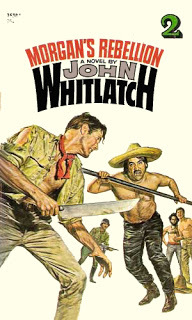 MORGAN’S REBELLION
MORGAN’S REBELLIONPrison made a man of Morgan. And the man became a legend.
Jamey Morgan—a quiet California citizen—was arrested on a business trip to Central America. Accused of aiding a revolution he knew nothing about, Morgan was deprived of all diplomatic rights, branded an international renegade, and sentenced to hard labor.
And so, the only way he could return to the United States was to overthrow the government that imprisoned him. He made the revolution his own. After escaping from prison, Morgan fled into the hills and joined the rebel forces. An experienced bowman, he trained and organized an extraordinary guerrilla troop—Los Arqueros, the Archers—fifty rugged men on horseback, armed with bows and explosive arrows. The exploits of this daring commando unit help bring a ruthless dictatorship to its knees—and brought fame, love, and fortune to Captain Jamey Morgan.
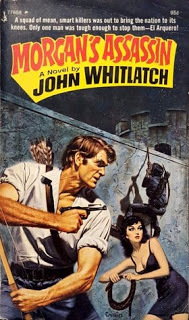 MORGAN'S ASSASSIN
MORGAN'S ASSASSIN They called him El Arquero...
The history books said bows and arrows had gone out years ago. But nobody had told James Morgan. Armed only with his great longbow, he had led a revolution that freed a Central American nation from tyranny. His men were all arqueros, or archers, but he was the only one called El Arquero.
Now, back in the States, Morgan received another call for help—from the F.B.I. This time it was to foil an assassination attempt that everyone else seemed powerless to stop. But then he discovered that he was next on the assassin's list. It was kill or be killed—and as Morgan stalked his man, he discovered he was up against the most diabolical political conspiracy America had ever seen. To defeat it, the arqueros would have to march again...
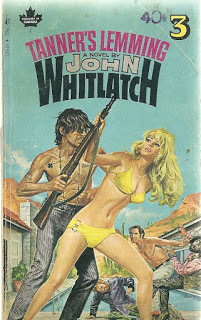 TANNER'S LEMMING
TANNER'S LEMMINGTanner—the man who single-fistedly quashed a student takeover and tongue-lashed its leaders into silence at a turbulent school-board showdown. Tanner—the man who had never flown a plane, yet took the stick when a pilot died in midair and landed safely. Tanner—the man whose blunt business sense had won him a place in a Senator's inner circle. Tanner—had he blown a hole in the heart of the man millions of Americans revered? Had he killed Senator Stanton? Could he have been the assassin?
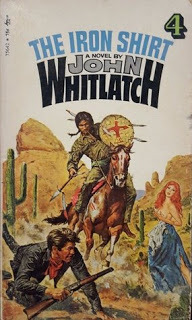 THE IRON SHIRT
THE IRON SHIRT Vengeance!
Jonathan Fontaine swore it...in the smoking remains of his homestead, over the charred, mutilated body of his young daughter.
He had gone East but now was back in Arizona with a specially equipped rifle.
And he had a fresh lead on the Indian—the one who had worn a necklace of human fingers and The Iron Shirt...
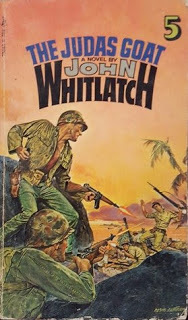 THE JUDAS GOAT
THE JUDAS GOAT Life had made them hard...The army made them mean!
The attack squad...Hand-nicked from the entire U.S. World War II army, they were a unique company. Twelve men led by a lieutenant, as able as he was arrogant, and a sharp, seasoned sergeant who was militantly silent about his past. Twelve fighters. among them an ugly man, a black man, an old World War I scout, a southern redneck, and a mountain climber. They were a strange assortment, but they had several things in common—They were tough and tenacious...and they didn't care too much about living.
To the General they were the army's answer to the marines. To the Colonel they were a crack team...the best he could assemble. To the lieutenant they were animals. And by the time their brutal training had ended they were killers.
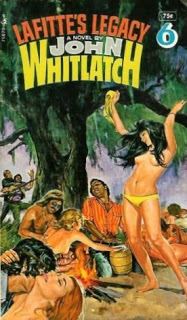 LAFITTE'S LEGACY
LAFITTE'S LEGACY Jean Larue returns the newspaper said...The last of the Latittes had come back from Arizona to visit his dying grandfather. But enemies lay in wait, blocking his way with fallen trees, terrorizing his wife with poisonous snakes, signaling their malice with voodoo dolls. Someone wanted the old treasure map that was his legacy. But his adversaries had not reckoned with the pirate blood that was also part of Lafitte's legacy. He would tight with all the guile and guts, tenacity and ingenuity that had made his legendary ancestor the terror of the bayou.
 FRANK T'S PLAN
FRANK T'S PLAN His daughter had been murdered...Frank T. had a painful score to settle. And his chance came when a jury freed the accused man, Martin Ballard. Lusting for vengeance, Frank T set out on a daring hunt to bring his prey back alive. But there was another group of desperate men who wanted Ballard dead. To get his man, Frank T would face death and terror with only his guts to get him through.
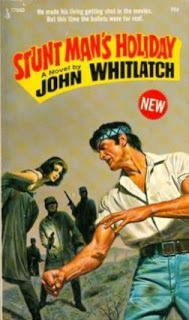 STUNT MAN'S HOLIDAY
STUNT MAN'S HOLIDAY Max Besh was one tough apache. They shouldn't have gotten him mad.
Max Besh, movie stunt man arid full-blooded Apache, was having quite a vacation in Las Vegas. He'd wan six grand at the crap tables and he'd gotten himself a curvy young dancer for companionship. Next thing he knew, he was looking down the barrel of a .38 and somebody was riding off with the cash and the girl.
What the kidnappers didn't realize was nobody pulls that kind of trick on Max Besh. They eluded police and crossed the Mexican border, but they couldn't shake the angry Indian on their trail. Even if it took a shootout, Max Besh was going to get his money and his woman back—in that order.
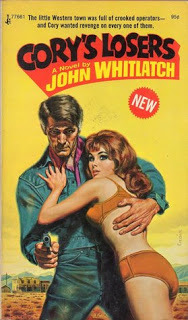 CORY'S LOSERS
CORY'S LOSERSWhen Cory had been stuck with that had murder rap, some of the town's solid citizens had moved in and taken everything he had. Now it was seven years later, and Cory was back with a score to settle.
Meanwhile, his enemies had become the most powerful, ruthless men in town. They knew Cory was coming, and they were ready for him.
But Cory had friends—the loserswho, like him, had been taken by the big honchos. Together, they were going to make things pretty hot for those crooked bastards...
 SHOOT-OUT AT DAWN: AN ARIZONA TRAGEDY
SHOOT-OUT AT DAWN: AN ARIZONA TRAGEDYJohn Whitlatch co-authored this book with Tom Power, one of the survivors of the event. There are but a handful of true west stories. The Power family story is one of those. From their simple beginnings in West Texas, to the furious gun battle a snowy winter day in Arizona, to decades of fighting for justice, theirs is a story of pain and courage. Tom and John Power—both blinded in their left eyes during the gun battle—and old, ex-Army Scout, Tom Sission, eluded a 3,000 man posse and soldiers for over a month in some of the most forbidding terrain on this planet. Their story is truly one of the most remarkable feats of courage and will ever played out in the American West.
Published on August 20, 2017 19:56
ALEX RIDER RETURNS
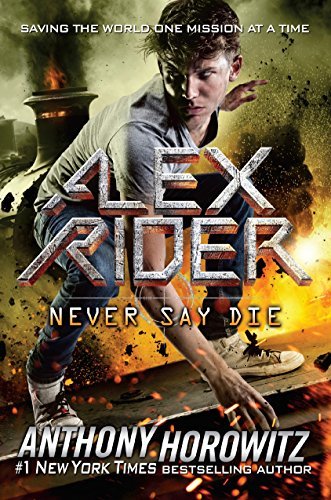 ALEX RIDER RETURNS
ALEX RIDER RETURNSThe Alex Rider books have long been my favorite Y/A spy series..Young Bond comes a close second with Robert Muchamore's Cherub series third...The Alex Rider books were supposedly brought to a conclusion with Scorpia twelve years ago, but apparently you can't keep a good spy down...Author Anthony Horowitz is, of course, currently writing the James Bond continuation novels (starting with the tepid Trigger Mortis) and was the force behind the brilliant British television series Foyle's War...
Published on August 20, 2017 10:26
August 19, 2017
WRITERS’ POLICE ACADEMY
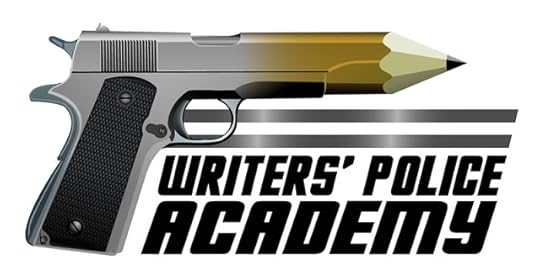 WRITERS’ POLICE ACADEMY
WRITERS’ POLICE ACADEMY If you’re an established or a budding mystery writer and you can only attend one writers’ conference next year, make sure it’s the Writers’ Police Academy 2018. I had the opportunity to be one of the guest speakers at this year’s Writers’ Police Academy—making a presentation on interrogation—and came away convinced it was the best writers’ conference or convention I’d ever attended...bar none.
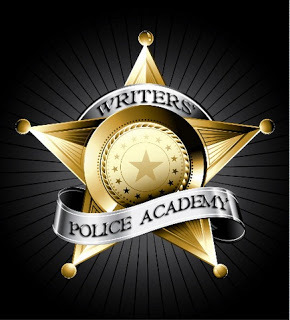 An exciting, fully immersive four day event, the Writers’ Police Academy gives attendees hands-on law enforcement, firefighting, EMS, and forensics experiences. The professional staff of law enforcement instructors provided training on an incredible range of subjects and activities including: Long Gun And Handgun Live Fire; Emergency Driving; Traffic Stops; Pursuit Termination Techniques; Defense and Arrest Tactics; SWAT Explosive Entry; Death Scene Investigation; Building Searches and Room Clearing; Shoot/Don’t Shoot Scenarios; Taser Training; Police Dogs; Evidence Collection and Processing; Narcotics; Prison Gangs; Mindset of Cops; Serial Killers; Fake/Genuine Suicide Notes; Arson Investigation; and so much more. The four track programming was so comprehensive and densely packed, it was impossible to do it all.
An exciting, fully immersive four day event, the Writers’ Police Academy gives attendees hands-on law enforcement, firefighting, EMS, and forensics experiences. The professional staff of law enforcement instructors provided training on an incredible range of subjects and activities including: Long Gun And Handgun Live Fire; Emergency Driving; Traffic Stops; Pursuit Termination Techniques; Defense and Arrest Tactics; SWAT Explosive Entry; Death Scene Investigation; Building Searches and Room Clearing; Shoot/Don’t Shoot Scenarios; Taser Training; Police Dogs; Evidence Collection and Processing; Narcotics; Prison Gangs; Mindset of Cops; Serial Killers; Fake/Genuine Suicide Notes; Arson Investigation; and so much more. The four track programming was so comprehensive and densely packed, it was impossible to do it all.
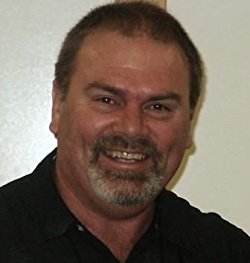 Cop turned writer Lee Lofland is the innovator of the Writers’ Police Academy. He and his staff work incredibly hard to ensure a seamless conference where writers can enhance the realism of their fiction in an educational and fun atmosphere. My experience at this year’s Writers’ Police Academy involved hanging out with 250 crime and suspense writers avidly participating in every scenario and skill thrown at them—including 20 of them who volunteered to wear a standard police utility belt with all the trimmings—gun, ammo pouches, handcuffs, CS gas, etc.—for the whole long weekend. I was also able to interact with twenty other staff instructors and a wonderfully uncountable number of volunteers (all in highlighter yellow T-shirts) who could have not been any friendlier. And all of this to help crime writers escape the Hollywood Effect of bad scenarios being perpetrated again and again—silencers on revolvers, anybody? How about getting DNA back between commercials?
Cop turned writer Lee Lofland is the innovator of the Writers’ Police Academy. He and his staff work incredibly hard to ensure a seamless conference where writers can enhance the realism of their fiction in an educational and fun atmosphere. My experience at this year’s Writers’ Police Academy involved hanging out with 250 crime and suspense writers avidly participating in every scenario and skill thrown at them—including 20 of them who volunteered to wear a standard police utility belt with all the trimmings—gun, ammo pouches, handcuffs, CS gas, etc.—for the whole long weekend. I was also able to interact with twenty other staff instructors and a wonderfully uncountable number of volunteers (all in highlighter yellow T-shirts) who could have not been any friendlier. And all of this to help crime writers escape the Hollywood Effect of bad scenarios being perpetrated again and again—silencers on revolvers, anybody? How about getting DNA back between commercials?
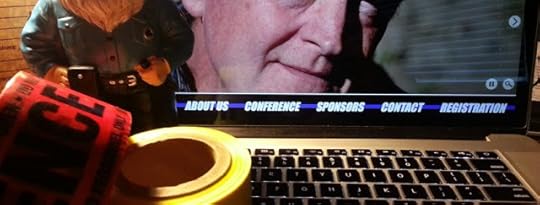 I was impressed by the high quality and professional résumé of the instructors. Most were attached to the Public Safety program located on the campus of the Northeast Technical College in Green Bay—used as an actual police academy by many local law enforcement jurisdictions. It was also the location of much of the provided training for the Writers’ Police Academy attendees, along with the nearby newly opened pursuit driving course, and the excellent conference rooms and facilities in the conference hotel. The bottom line is, the Writers’ Police Academy is an action-packed and thrilling weekend of playing real-life cops and robbers. If you plan to attend in 2018 here are some tips to make your experience the best it can be...
I was impressed by the high quality and professional résumé of the instructors. Most were attached to the Public Safety program located on the campus of the Northeast Technical College in Green Bay—used as an actual police academy by many local law enforcement jurisdictions. It was also the location of much of the provided training for the Writers’ Police Academy attendees, along with the nearby newly opened pursuit driving course, and the excellent conference rooms and facilities in the conference hotel. The bottom line is, the Writers’ Police Academy is an action-packed and thrilling weekend of playing real-life cops and robbers. If you plan to attend in 2018 here are some tips to make your experience the best it can be... Wear comfortable clothing as it is nearly impossible to duck live ammunition, crawl under loops of barbed wire, and defend yourself against twelve knife-wielding attackers while wearing heels and a skintight leather jumpsuit like many action move heroines.
Bring only the things you need to the academy grounds. It’s tough to kick in doors and perform a PIT maneuver if you’re constantly juggling the contents of a purse big enough for a pack mule. However, sunscreen, sunglasses, bottled water, and a light jacket should be part of your personal gear bag.
Make ahead of time for any child care issues you may have. There are no child friendly options at the Writers’ Police Academy. However, there is a timeout corner for misbehaving adults—most often those who may think it’s okay to keep their phone video app running when the no video rule is implemented.
Cameras used for still shots are acceptable with an instructor’s okay.
Bring a photo ID and keep it with you at all times while at the police academy. Some of the activities do require ID and background checks. For instance, you need a valid driver’s license to participate in any vehicle related activities. Book covers/dust jackets do not count as official ID.
When participating in those emergency driving workshops, keep hands and feet inside the car at all times—especially while spinning wildly out of control.
Be sure to attend the Thursday night orientation. This is where secret details about the event are provided—where to go, when to go there, what to expect when you arrive, what to do and say if captured, schedule changes, classroom number changes…Treat it like a shift change roll call and be there. Besides, it’s fun.
Camping is not allowed at the academy, so be sure to book your hotel accommodations ahead of time—the main conference hotel books up quickly.
The hotel bars and casino are well-stocked with alcohol, so pace yourselves. They will not run out of your favorite beverage. Only TV and movie detectives can drink themselves into oblivion and show up for work the next day popping aspirin and breath mints. Keep in mind the next morning will indeed arrive, and it will include lots of loud gunfire, sirens, and barking, snarling police dogs.
Remember to bring cash and/or credit cards in order to unload a boatload of dollars at the raffle, auction, and silent auction, during the banquet evening. The prizes are unbelievable. This year included a cool guitar signed by the Oak Ridge Boys, a PR package worth nearly $3000, a manuscript review by a top Harlequin editor, two seats at a law enforcement only gang conference, and a ton more.If this sound as if it’s the conference for you, be sure to sign up as soon as registration opens for 2018. Be prepared to take copious notes at the speed of light, to find the answers to questions you didn’t even know you had, identify those things you want/need to know more about for you writing, and make many potential contacts among the speakers and instructors—many of whom are happy to give out their emails to answer any questions that might arise about procedure, etc.AND REMEMBER...
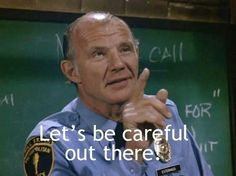 FOR MORE ABOUT THE WRITERS’ POLICE ACADEMY CLICK HERE
FOR MORE ABOUT THE WRITERS’ POLICE ACADEMY CLICK HERE
Published on August 19, 2017 17:59
LOGAN LUCKY—OCEAN’S 7-ELEVEN
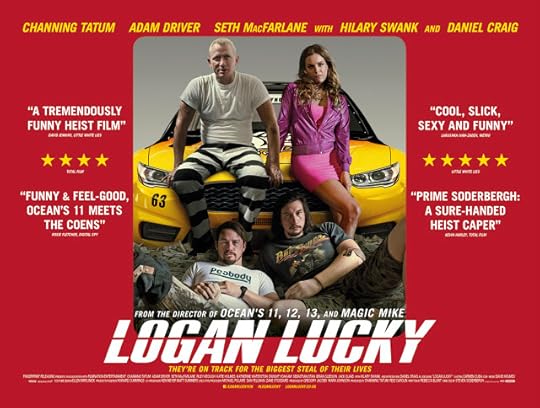 LOGAN LUCKY—OCEAN’S 7-ELEVEN
LOGAN LUCKY—OCEAN’S 7-ELEVENDon’t ask me to explain the details of Steven Soderbergh’s latest heist film, Logan Lucky, because I can’t—but that doesn’t mean I didn’t enjoy this Southern fried Ocean’s 7-Eleven to the fullest.
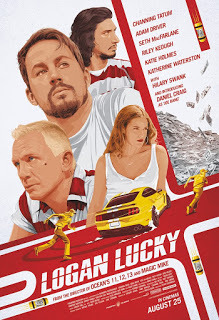 I can’t take credit for the above clever 7-Eleven quip, which references the film director’s prior forays into classic heist film territory. It is a throwaway line used by the film's TV anchor reporting on the heist of the huge cash take at the Charlotte Motor Speedway in North Carolina during the running of NASCAR’s Coca-Cola 600. For anyone unfamiliar, 7-Elevens are convenience stores famous for Slurpees, ptomaine hotdogs, and being referred to in LA as Stop-n-Robs.
I can’t take credit for the above clever 7-Eleven quip, which references the film director’s prior forays into classic heist film territory. It is a throwaway line used by the film's TV anchor reporting on the heist of the huge cash take at the Charlotte Motor Speedway in North Carolina during the running of NASCAR’s Coca-Cola 600. For anyone unfamiliar, 7-Elevens are convenience stores famous for Slurpees, ptomaine hotdogs, and being referred to in LA as Stop-n-Robs.But Logan Lucky has a wide variety of far more clever ingredients and set pieces, which don't need the joke explained. I had a big smile on my face as one part of the heist after another clicked into place. Despite being a fuzzy on the details, I was caught up in whatever was to come next--and in not knowing what it was going to be. While all of this is straight by the numbers from Soderbergh’s usual bag of tricks, there is enough depth of characterization, poignancy, and charm to turn it's moonshine sensibilities into Southern Comfort.
While none of this is supposed to be taken seriously, there is a serious attempt not to treat to the audience as if it had a negative tooth to tattoo ratio. And if several secondary characters verge on inbred Southern stereotypes, Soderbergh never treats them with contempt. Instead, he handles them with a subtle sense of humor and a certain endearing affection.
It also helps that Channing Tatum and Adam Driver never push their working class characters into parody. Driver’s prosthetic arm—the original lost in Iraq—even becomes a brilliant bit of emotional misdirection used to cover a raft of plot holes. With Tatum and Driver consciously underplaying their parts, Daniel Craig—as the blond, buzz-cut, tattooed, Joe Bang—is able to let loose without fear of turning the film into an episode of The Dukes of Hazzard or the slapstick comedy of Talladega Nights.
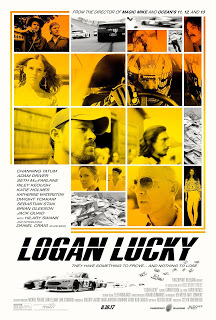 As in many of his films, Soderbergh's directorial technique purposely doesn’t allow his stars to disappear into their characters. Instead, you are acutely aware of the actors you are watching while also being aware of each Soderbergh touch as it appears on the check list. Strangely, this calculated method has the effect of somehow making the film stronger—the professional chops on the screen avoiding deterioration into scenery chewing because the script keeps everything twisting and turning.
As in many of his films, Soderbergh's directorial technique purposely doesn’t allow his stars to disappear into their characters. Instead, you are acutely aware of the actors you are watching while also being aware of each Soderbergh touch as it appears on the check list. Strangely, this calculated method has the effect of somehow making the film stronger—the professional chops on the screen avoiding deterioration into scenery chewing because the script keeps everything twisting and turning. Special kudos are due to Farrah Mackenzie playing Channing Tatum’s young daughter—who tugs at your heartstrings at the perfect moment. Also to Hillary Swank, who puts in a late appearance as a tightly wound FBI agent, and gets to put the final twist in the tail.
While you never get to completely suspend your disbelief, the sum of the parts is a ridiculous fun and quirky ride fueled by Moon Pies and RC Cola.
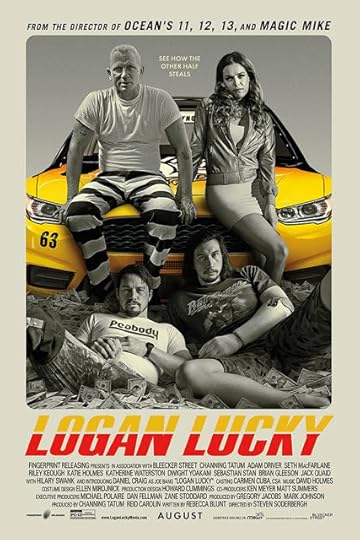
Published on August 19, 2017 07:52
August 18, 2017
LOGAN LUCKY—OCEAN’S 7-ELEVEN
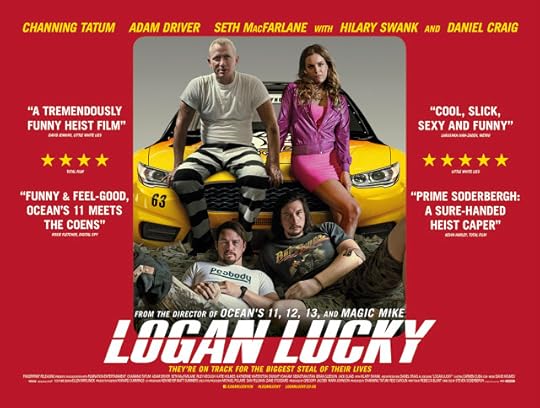 LOGAN LUCKY—OCEAN’S 7-ELEVEN
LOGAN LUCKY—OCEAN’S 7-ELEVENDon’t ask me to explain the details of Steven Soderbergh’s latest heist film, Logan Lucky, because I can’t—but that doesn’t mean I didn’t enjoy this Southern fried Ocean’s 7-Eleven to the fullest. I can’t take credit for that clever quip referencing the film director’s prior forays into classic heist film territory. It is a throwaway line used by a TV anchor reporting on the heist of the huge cash take at the Charlotte Motor Speedway in North Carolina during the running of NASCAR’s Coca-Cola 600.
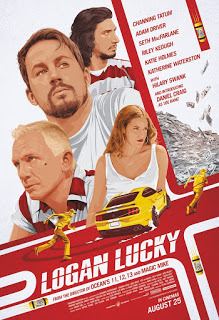 Logan Lucky has a wide variety of clever ingredients and set pieces, which put a big smile on my face as one part after another clicked into place—despite being a fuzzy on the details. While all of this is straight by the numbers from Soderbergh’s usual bag of trick, there is enough poignancy floated on a gentle sense of humor to have you leaving the theater feeling upbeat and pleased with the experience.
Logan Lucky has a wide variety of clever ingredients and set pieces, which put a big smile on my face as one part after another clicked into place—despite being a fuzzy on the details. While all of this is straight by the numbers from Soderbergh’s usual bag of trick, there is enough poignancy floated on a gentle sense of humor to have you leaving the theater feeling upbeat and pleased with the experience.Channing Tatum and Adam Driver never push their working class characters into parody. Driver’s prosthetic arm—the original lost in Iraq—even becomes a center piece, a brilliant bit of misdirection to cover a raft of plot holes. With Tatum and Driver consciously underplaying their parts, Daniel Craig—as the blond, buzz-cut, tattooed, Joe Bang—lets loose without fear of turning the film into an episode of The Dukes of Hazzard or the slapstick comedy of Talladega Nights.
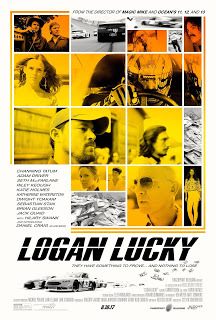 Special kudos are due to Farrah Mackenzie playing Channing Tatum’s young daughter—who tugs at your heartstrings at the perfect moment. Also to Hillary Swank, who puts in a late appearance as a tightly wound FBI agent who gets to put the twist in the film’s tail.
Special kudos are due to Farrah Mackenzie playing Channing Tatum’s young daughter—who tugs at your heartstrings at the perfect moment. Also to Hillary Swank, who puts in a late appearance as a tightly wound FBI agent who gets to put the twist in the film’s tail.As in many of his films, Soderbergh doesn’t allow his stars to disappear into their characters. Instead, you are acutely aware of the actors you are watching (while also being aware of each Soderbergh touch as it appeared on the check list), but the effect somehow makes the film stronger. The professional acting chops on the screen avoid deteriorating into scenery chewing because the script keeps everything twisting and turning. None of it is supposed to be taken seriously, but there is a serious attempt not to play down to the audience, or to allow Southern stereo-types to be treated with contempt. While you never get to completely suspend your disbelief, the sum of the parts is a ridiculous fun and quirky ride fueled by Moon Pies and RC Cola.
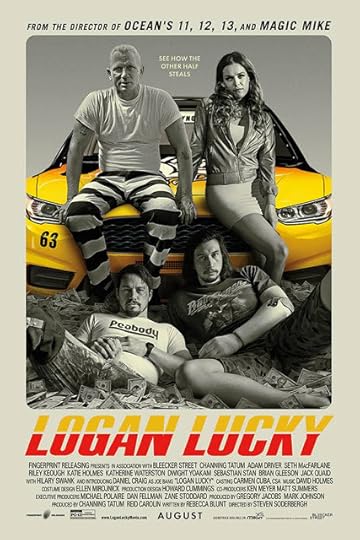
Published on August 18, 2017 23:05
August 16, 2017
SHOCK TROOPS OF JUSTICE
 SHOCK TROOPS OF JUSTICEPULPS VS. REALITY
SHOCK TROOPS OF JUSTICEPULPS VS. REALITYAs the 1930s progressed, pulp magazines exploded in popularity. The demand for stories of all kinds was voracious. Each month hundreds, if not thousands, of tales were needed to fill the harsh, wood-chipped, pages behind the pulp magazine’s lurid cover paintings.
Paid a cent a word or often less, the top pulpsters knew they needed to keep throwing one word after another in order to keep whiskey in their bottles and, perhaps, food on their family’s tables. Less experienced wordsmiths realized their chances of making a living increased with every story they pounded out on letter-sticking typewriters.
Although there were a handful of pulp writers who were both fast and entertaining, for lesser writers being fast more often took precedent over being good. The demand for product thrived on creativity—purple prose, imagination, and character drove the action in order to overcome plot holes and realism.
Obviously, there was no Internet for quick fact checks. If a writer didn’t know what procedures were used in the real world or how scientific principals actually worked, he made something up to fit the needs of the story. Time to research stories meant less time for writing, missed deadlines, and missed pay checks. The writing itself became the be all and end all of the pulp writer’s life.
Robert Mill, however, saw things differently. Mill saw the intrepid values imbued upon fictional pulp heroes in the reality of a group of real life men—the special agents of J. Edgar Hoover’s Bureau of Investigation.
Mill’s enthusiasm for these new paragons of justice was unfettered by his need to simply tell stories to get paid. He was moved to tell real stories (or as real as the pulp market would allow) using the real techniques developing in law enforcement, which enraptured his imagination.
Mill’s believed his idolization of the bravery of those true-life individuals in the service of their country should, and would, be shared by his readers. He recognized the fascination the everyman had, and still has today, with the gritty realism of real law enforcement.
In a time when the techniques of fingerprinting, criminal profiling, and crime scene investigation were in their infancy, Mill found his pulp niche. He researched not only the techniques, but also the methods, personal lives, and stresses faced by real special agents taking on criminal gangs of kidnappers, robbers, and thieves. The fascinating world he discovered fueled his creation of square-jawed Special Agent James Ashby and the behind-the-scenes characters who worked to help him be successful.
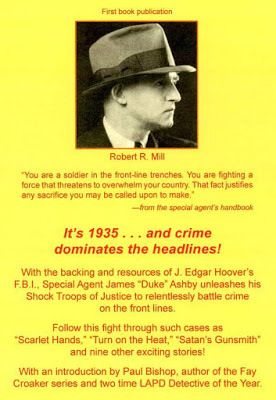 Mill’s stories collected within the pages of Shock Troops Of Justice are a delight to read. Presented in the order in which they were written, it’s interesting to see how Mill learns to blend his enthusiasm for realistic police work while still maintaining the pulp stylings appropriate to his markets—purple prose and criminal argot garnishing the real world research, giving authority to Mill’s storytelling so lacking in the frippery of his contemporaries.
Mill’s stories collected within the pages of Shock Troops Of Justice are a delight to read. Presented in the order in which they were written, it’s interesting to see how Mill learns to blend his enthusiasm for realistic police work while still maintaining the pulp stylings appropriate to his markets—purple prose and criminal argot garnishing the real world research, giving authority to Mill’s storytelling so lacking in the frippery of his contemporaries.From the workings of the newly established crime labs to the techniques of information gathering, to the dangers of being deep undercover, Mill researched it in-depth. He then wrote his tales with the confidence of a man passionate and knowledgeable about his subject. Hoover’s schoolboys couldn’t have had a more ardent proponent.
Because of Mill’s skill at imparting his real world knowledge of law enforcement procedure, these tales hold up remarkably well when compared to the more fanciful tales of Mill’s contemporaries.
In the preface to Shock Troops Of Justice, Mill tells us about crime and society:
The police of the cities were powerless to combat the monster. Some were honest, but incompetent. Others were efficient, but dishonest. Still others, both honest and efficient, were made impotent by grafting politicians. But whatever the case may have been, it is an unchallenged fact that for long months and years, the underworld held a decided advantage in the constant war between police and evildoers.
Having had a thirty-five career as a detective with the Los Angeles Police Department (honest and—hopefully—efficient), I can reliably say not much has changed. The criminal argot is different, gangs and cons have come and gone, technology has advanced, but the underworld still appears to have a decided advantage in the constant war between police and evildoers. We need Special Agent James Ashby and men and women like him today more than ever.
Published on August 16, 2017 11:38



